1lumen selects and reviews products personally. We may earn affiliate commissions through our links, which help support our testing.
Acebeam P17 review
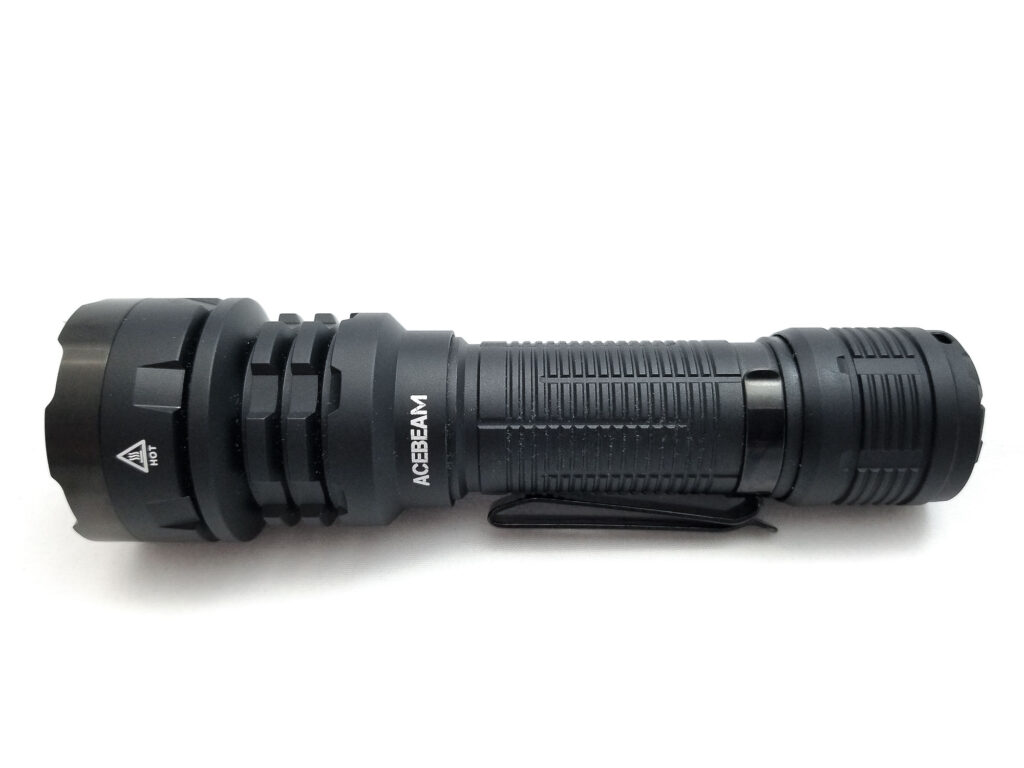
Acebeam P17 specifications
| Brand & Model | Acebeam P17 |
|---|---|
| Flashlight category | Tactical flashlight, General Purpose |
| LED | Cree XHP70.3 HI |
| Max. output | 4900 lumens |
| Max. beam distance | 445 meters |
| Max. beam intensity | 49,506 cd |
| Battery config. | 1*21700 |
| Onboard charging | Battery has USB type C Port |
| Modes | 5 |
| Blinkies | Strobe, S.O.S |
| Waterproof | IP68 |
| Review publication date | January 2023 |
Introduction:
If you know flashlights, you’ve probably heard of Acebeam. Flashlight enthusiasts and regular folks appreciate the top-notch build quality, excellent electronic packages, premium LEDs, and innovative designs and features like the fantastic L series tactical throwers, the fidget-y EDC Rider, and recent releases like the X50 and X75 solidify Acebeam’s position and serious cred in this industry. In short, Acebeam walks the walk and talks the talk.
In late 2022, Acebeam added some new tactical-themed lights to the Defender P-series lineup. I reviewed the first release, the P15 Defender, which was a sophisticated, but quirky, WML light that could moonlight as an EDC light (well, sort of). The P15’s weirdness aside, it’s now been joined by the P16, P17, and P18. These represent larger, higher output lights with new designs and features. Acebeam was nice enough to send over the new P17 Defender, so I’ll be taking a look and running it through our battery of tests. This is a pocketable dual-switch tactical-use light sporting one of my favorite LEDs, dual-switch UI, and a gnarly strike bezel. I’m a big fan of Acebeam products and have reviewed several, so. I know the P17 will be good, but how good? There’s some stiff competition from Fenix and Nitecore, so let’s see!
Package quality.
Acebeam has had a bit of a packaging renaissance of late with their newer lights (especially the P-series) featuring upper-scale boxes and themes. While the L-series came in plain-Jane, Sofirn-esque boxes, the P17 has a very upscale look and a more price-appropriate look and feel. It’s still retail-friendly, but looks nicer.
- Acebeam P17
- USB A to C charging cable
- User manual
- Warranty documentation
- Acebeam-branded IMR21700NP-510A 21700 battery (in the light)
- Spare o-rings
Hey, Acebeam threw in the battery this time! Nice. Unlike other Acebeams where the battery is optional. I’m glad to see this light comes with everything you need to start slinging photons. The USB cable is exceptionally high quality, but exceptionally short, like under 8 inches, and borderline (dare I say?) useless unless using it with a power bank. Oddly, there’s no holster included here, and while not a huge deal, it would be a nice addition. Also, where’s the lanyard? I get it that lanyards are becoming a bit ambiguous, but in this demographic, I can imagine it would be nice to have. Come on Acebeam, give a guy a lanyard.
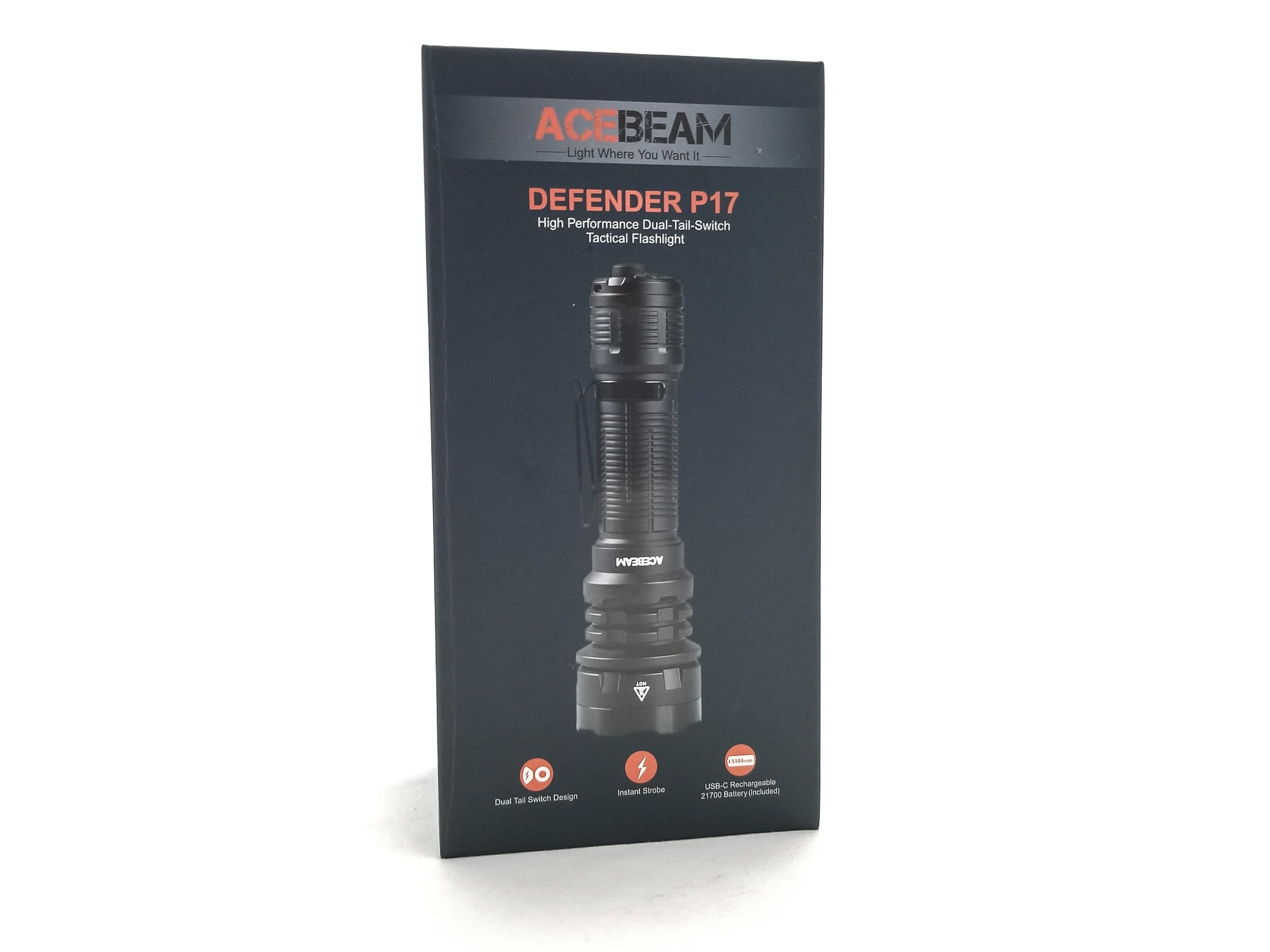
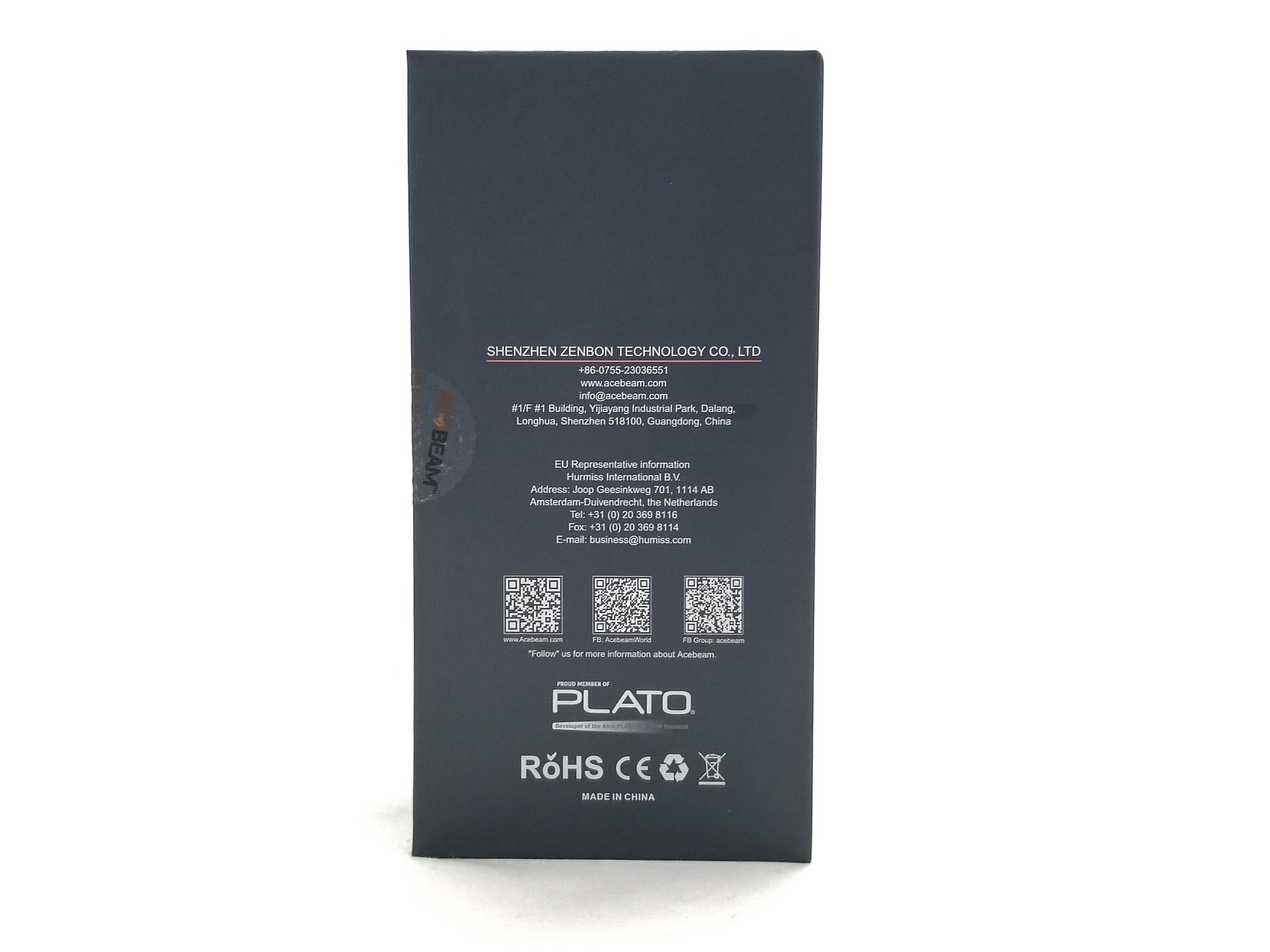
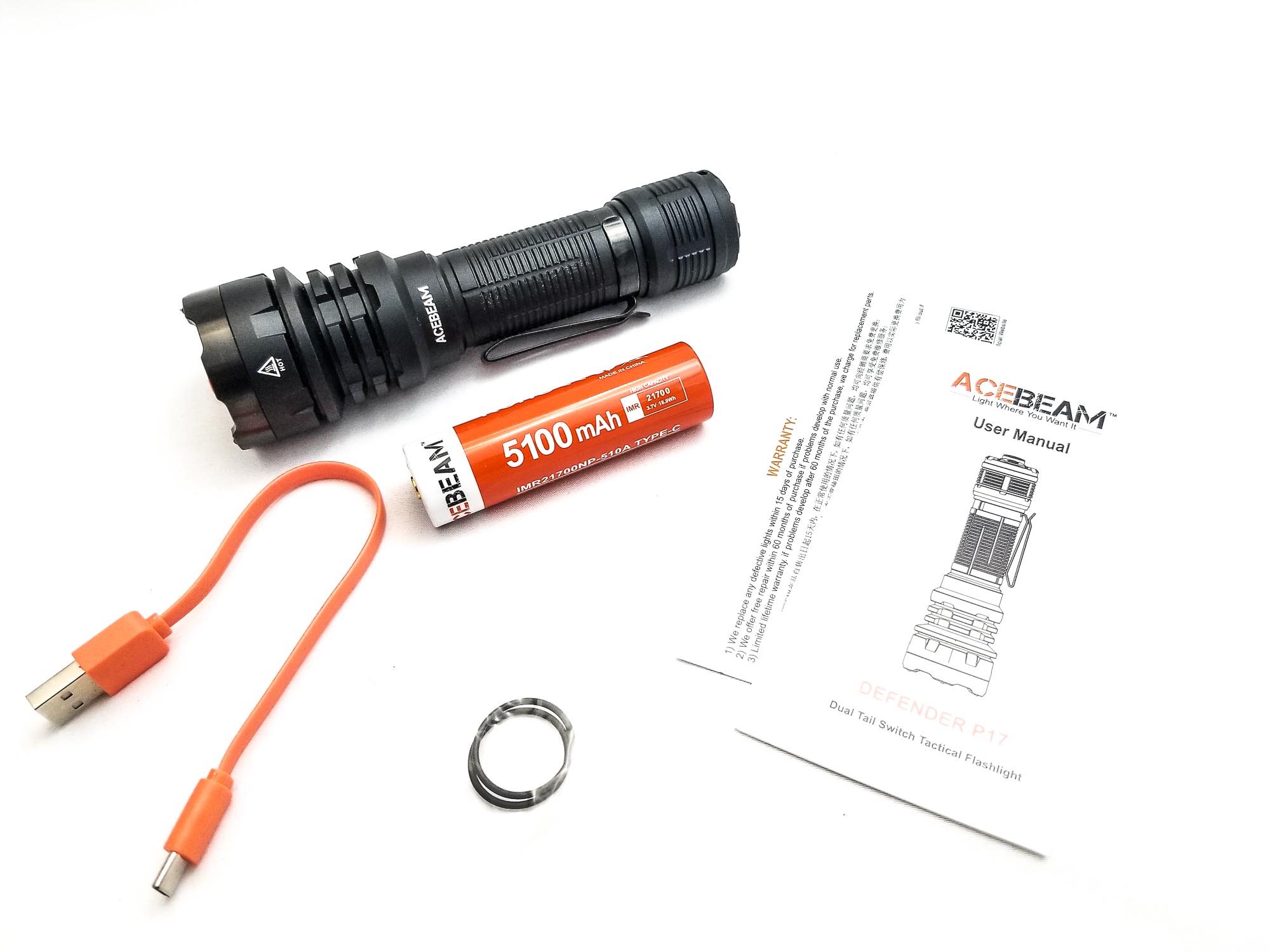
Flashlight in use
The Acebeam P17, like the other P series lights, was designed with a single mission: Tactical-use. There’s a ton of flashlights claiming to be tactical use, but 95% of those are just hardcore posers and the only thing tactical about them is the name. They’re mostly just general-purpose lights, and most are cheap zoomies. This P17 however, is designed as a no-nonsense tactical light. It can break windows (or other things), happily go on amphibious assaults, blind baddies, and light up fatal funnels or dark places where 2-legged critters may be hiding.
Handling-wise, for a 21700 size duty light, it’s smaller than I expected. Overall, it’s a great fit for my hands, and I’d say most folks would concur, and it feels and handles very intuitively. The design is very flashlight-y with extra deep cooling fins behind the head and gripping surface. The controls are out back, with the almost bulbous removable tailcap featuring a dual-switch arrangement. The tailcap as well as the body has lots of groves and texturing for a super secure grip and the tube is short enough to use one-handed, which is critical in true tactical use lights since when you really need a free hand, you really need a free hand.
There’s a friction fit, removable dual-position pocket clip, and it’s held on very securely, but comes off with some persuasion. There’s two lanyard holes opposite each other on the tailcap, but they’re pretty small, so threading a lanyard might be a bit like asking a lion to eat vegetables. This light is pocketable, but it’s not what I’d call an EDC. It’s a bit too bulky for daily carry, but since I aim to please ya’ll, I tried it out, and well…let’s just say bulging pockets shaped like a flashlight aren’t my thing. I think the P17 would be happier riding on your ballistic vest, duty belt, MOLLE gear, or turnouts.
The switches are the centerpiece of the P17, and sort of a new thing for Acebeam. I’m used to these on Fenix, Klarus, and Nitecores, so it’s nice to see them jump in and join the club. There’s a large round switch and a smaller, paddle-type switch. The bigger switch (the Tactical switch) is a forward clicky, and the smaller one (the Functional switch is an e-switch for momentary use only. Each can operate independently to control different functions and the three mode groups. The switches feel good, but I felt like they could be a bit more clicky and snappy. The Tactical switch has a very proud boot that has some give to it before engaging the switch button, so it felt a bit soft at first. The Function switch has a rigid texture, and it took some force to activate, but I felt like it could be better since it requires direct pressure to activate. In this case, I prefer Fenix’s style with proud rubber covers on the function switch. The important thing here is both switches could be activated one-handed with my thumb, an important feature for a light like this.
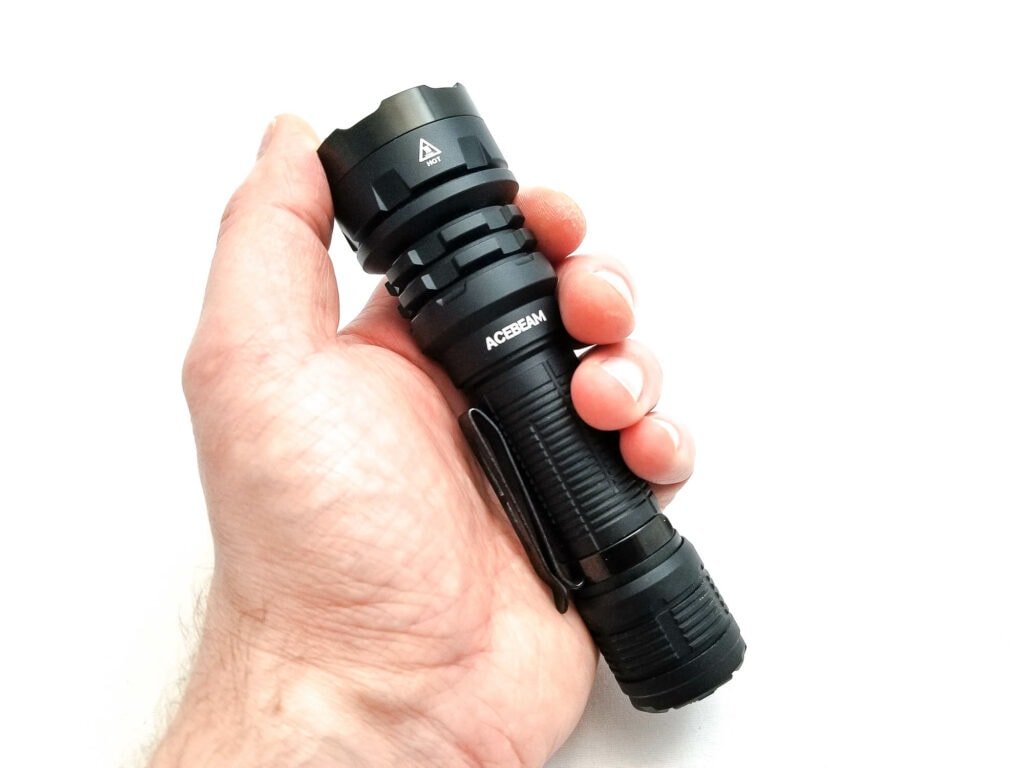
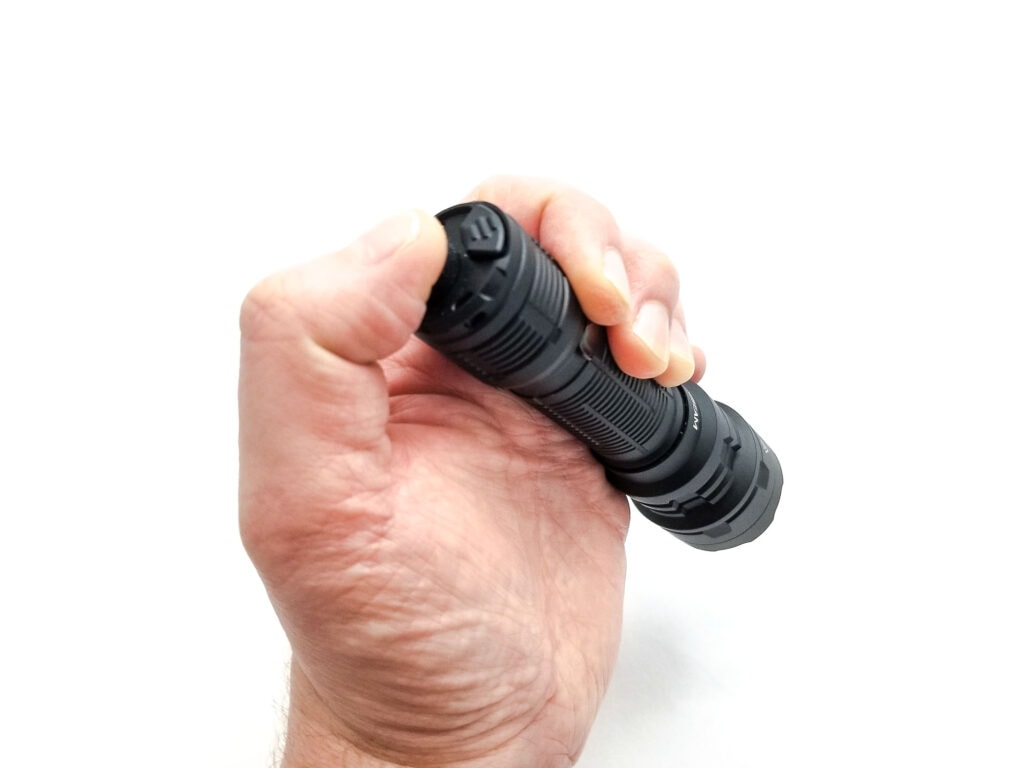
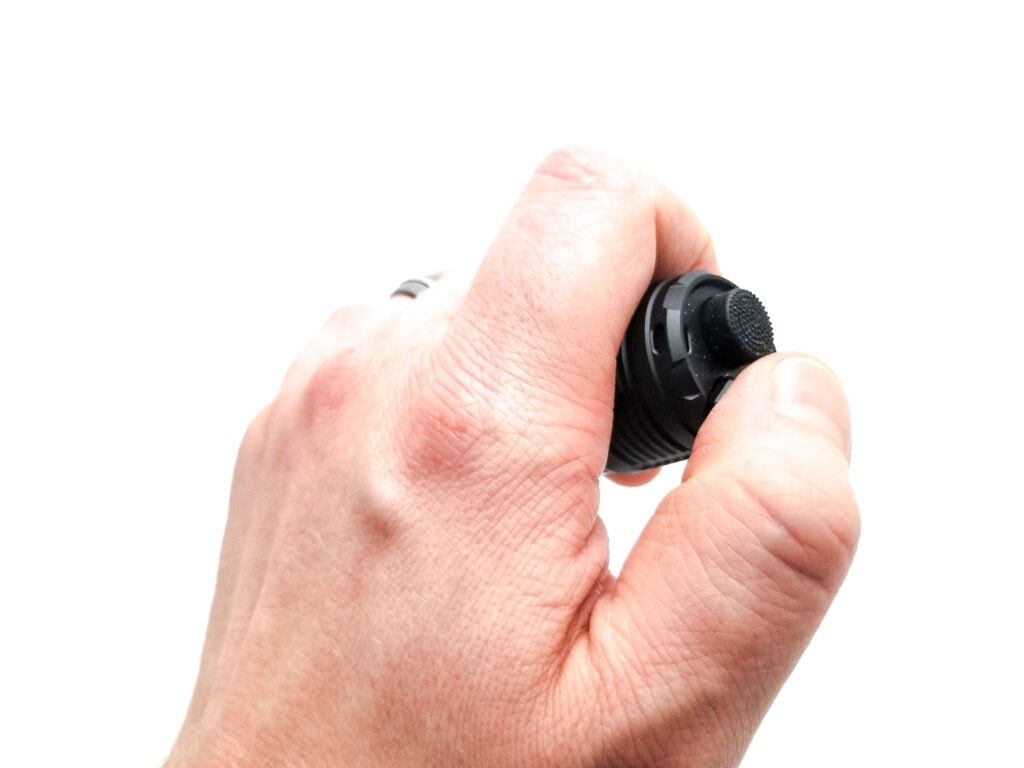
Build Quality, and Warranty
It’s no secret that Acebeam makes exceptionally high-quality lights with excellent fit and finish and quality control. The P17 is no exception, and the price reflects this, with an MSRP of around $120. Expensive? Yah, but you get what you pay for, and it’s competitively priced against competing Nitecore and Fenix options.
The P17 is milled from high-quality 6061-T6 aircraft aluminum, and it’s perfectly done with no blemishes, tool marks, burrs, nada. All the edges are blended and melted as well. There’s no large gaps anywhere, and the part fit-up is very tidy. Typical Acebeam stuff. The anodizing is classified as type III HA, and I’d put money down it’s going to be close to the true MIL-A-8625 spec thickness (0.0005 to 0.0030 inches…very thick). It’s black (but also comes in gray), and if you’ve read my other Acebeam reviews, this is among my favorite finishes in the flashlight continuum with a nice grippy satin feel to it. I didn’t see any blemishes or anomalies in the finish, and the coverage is flawless. The silkscreen text and laser engraving is also very nicely done and very edge is chamfered and smoothed. The threads on both ends of the battery tube are bare, with stout rectangular cut threads. Lubed out of the box, they were exceptionally smooth.
For springs, true to the professional-use audience, there’s two (actually four), with the driver and tailcap sporting dual, thick gold-plated springs to prevent damage to the driver and connection breaks under shock loading. This is mandatory for duty lights since they need to be reliable under ‘duress.’ The battery tube is removable, and is designed with a dual electrical path for the e-switch and mechanical switch to work together. However, here’s where the design differs from other dual tube designs. The tube is actually a single piece with a bottom cap with a round opening for the driver spring, with an electrically isolated anodized inner section to direct the electrons to the right spot. This is a superior design to a captured or uncaptured dual tube since it’s more robust and sturdy. There’s o-rings sealing every joint as well, and with no exposed ingress points other than the tailcap, Acebeam gives the P17 an IP68 rating.
Acebeam, like other higher-end manufacturers, has a very comprehensive warranty. From Acebeam: If the customer experiences any problems caused by manufacturing defects in normal use with an Acebeam product within 15 days of purchase, the dealer will replace that product. 2. If an Acebeam flashlight fails during normal use and any problem covered under warranty occurs within a period of 5 YEARS (60 months) of purchase, the dealer is responsible for warranty service. 3. Acebeam flashlights enjoy a limited lifetime warranty – after 60 months the dealer will attempt to repair the flashlight for the cost of spare parts and shipping (i.e. no charge for labor).
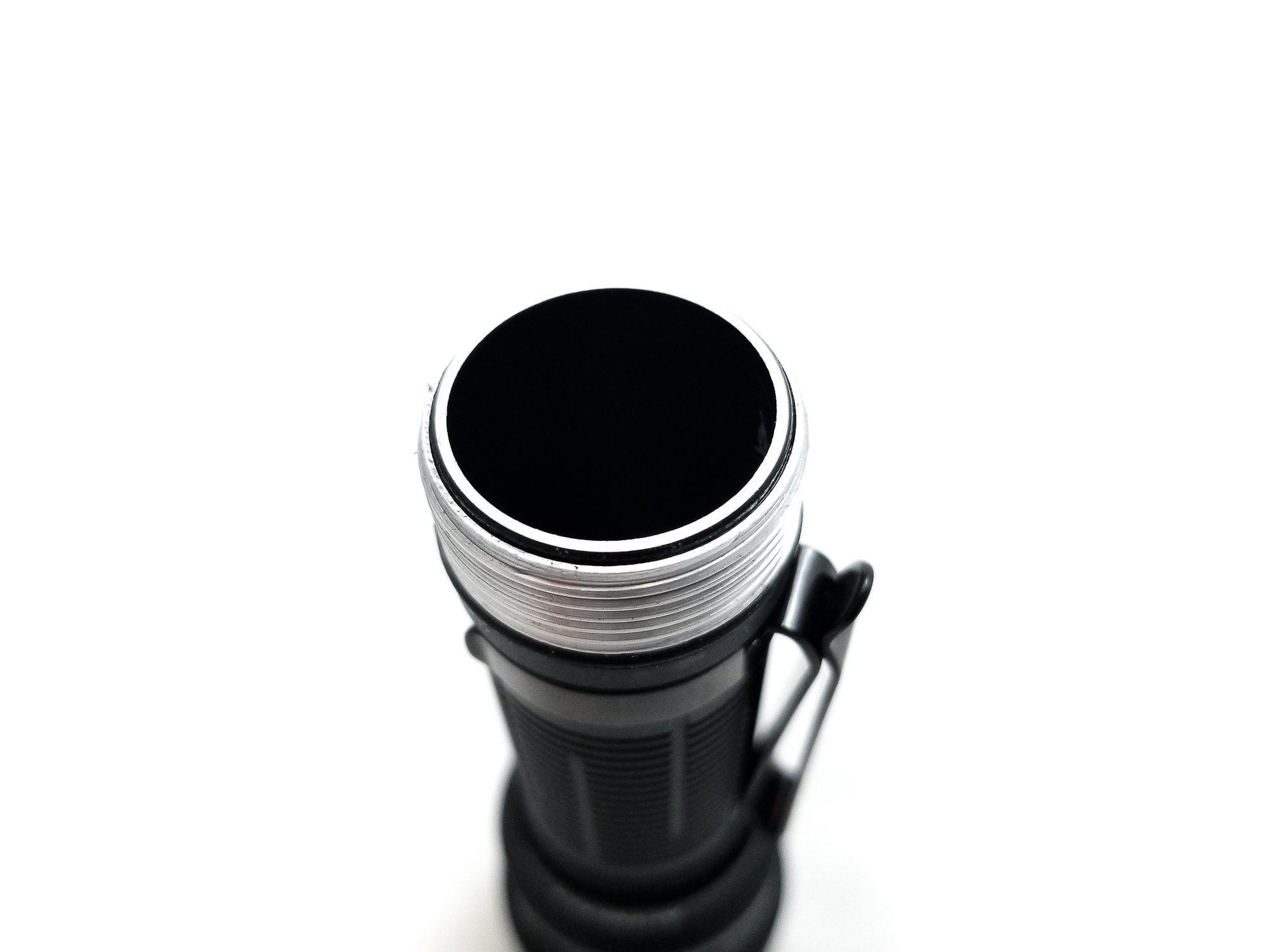
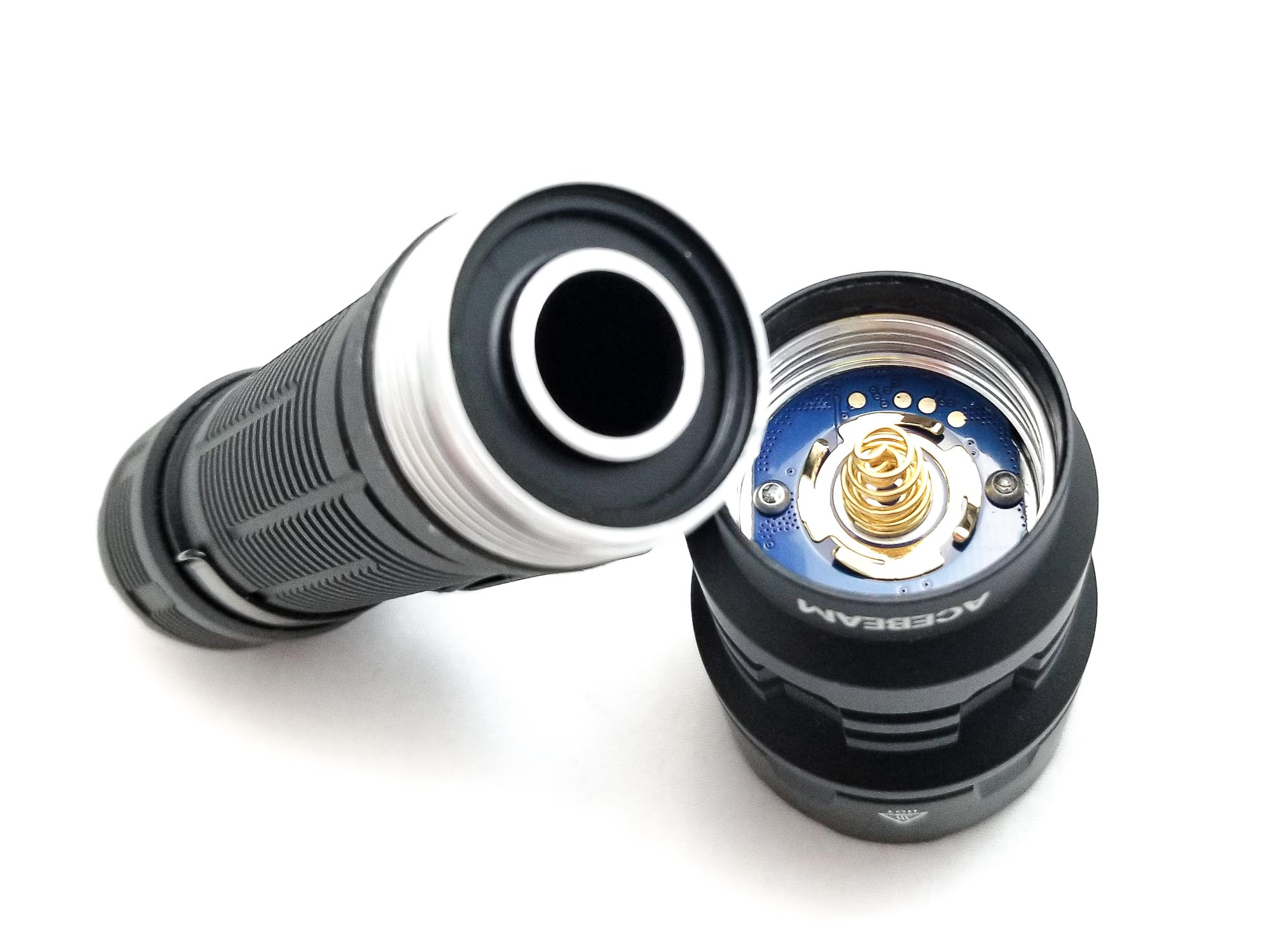
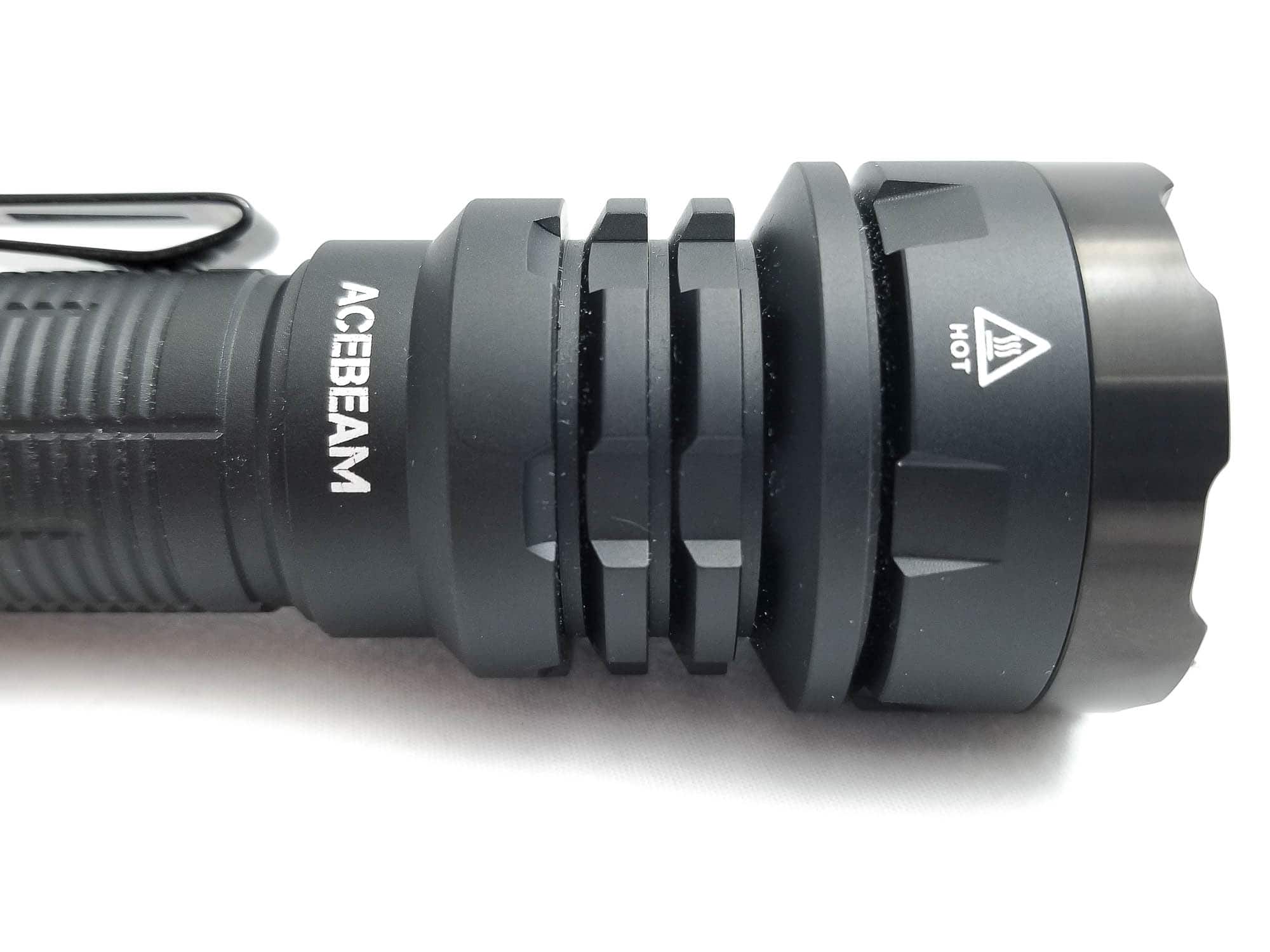
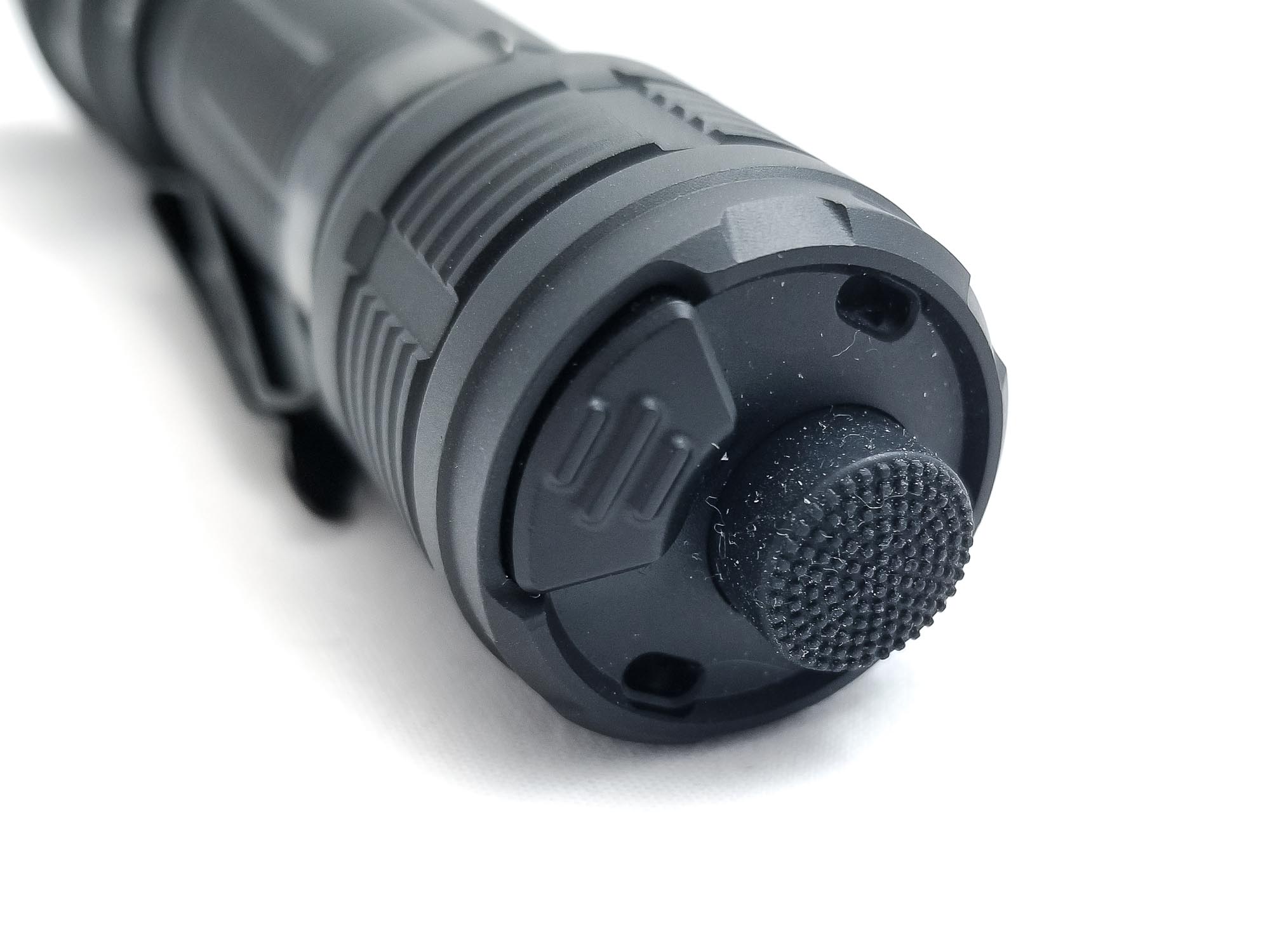
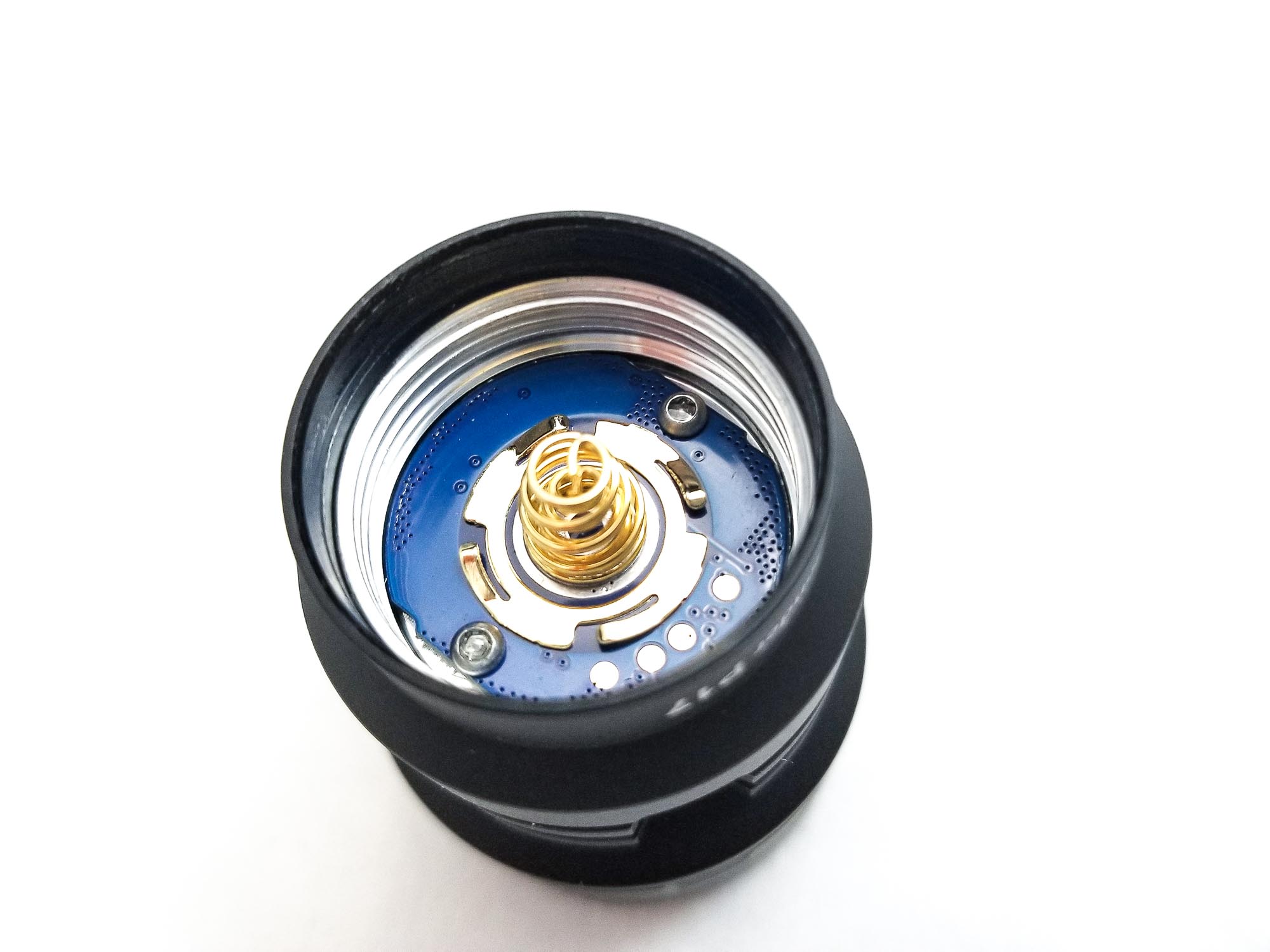
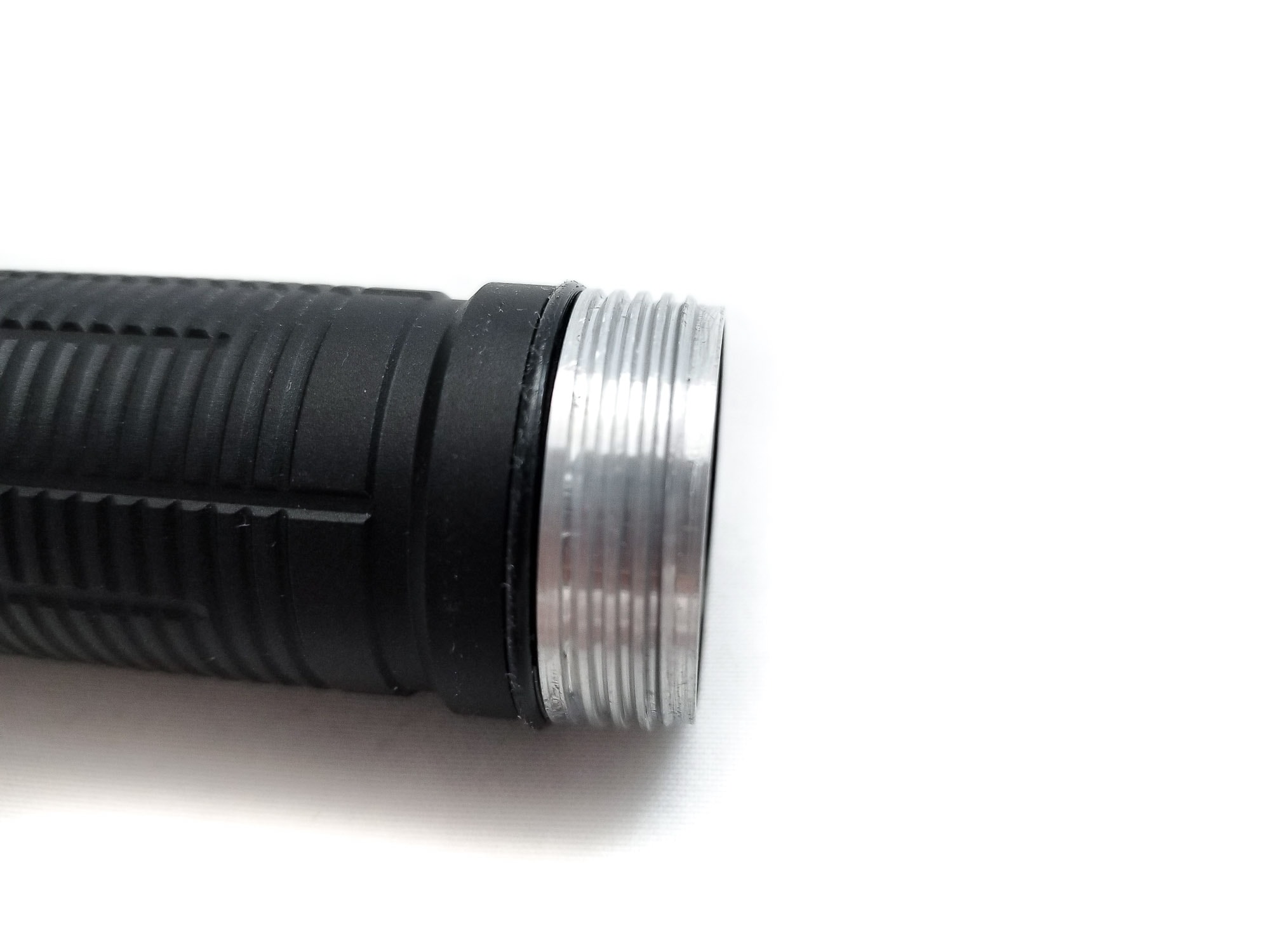
LED, Lens, Bezel, Beam, and Reflector
The P17 features a relatively new LED, and it’s one of my favorites. Acebeam is forthright about the LED they use, which is nice, but most buyers of the P17 probably won’t care. Most lights in this category are fielding the 5050-size LEDs from Cree and Luminus (XHP50.x, SST70 or SFT-70). The P17 however has done one better and is sporting the Cree XHP70.3 HI (sans dome). This is the 3rd generation of the XHP70 series LED, a quad-die CSP (no bond wires) 7070 size LED. The XHP series are part of Cree’s extreme performance, high output white LEDs. I really like the 3rd gen of this LED, and am thrilled Cree finally took the dome off for us (no more slicin and dicin) to increase the cd/mm2 and clean up the double-ugly, pee-yellow-to blue tint shift we get in the domed versions. This XHP70.3 is cool white, and the Opple Lightmaster Pro has the tint coming in around 6742K at 71.4 CRI Ra, typical and expected here. The duv is 0.0020 so less green and blue, which is good. For a CW LED, the tint isn’t too bad.
The bezel is an aggressively crenulated PVD-coated blackened stainless unit. It looks awesome with the black-on-black color theme, and this one has 3 silicon nitride ceramic tips for breaking windows like the Cyansky K3 and Fenix TK series. It extends about 5 mm over the lens at the highest point, so the lens is well protected from encounters with said window or hard objects. The lens is a hardened mineral glass unit with AR coating. It covers a shallow OP reflector to help smooth out any chromatic aberrations from the non-monolithic LES. It does a great job. Combined with the domeless LED, the beam has a nice defined hotspot that smoothly transitions to bright spill. There’s still a modicum of tint shift, but it’s nowhere near as pronounced as it is with domed XHP’s with no corona to boot. There’s more than enough reach here, and it’s easy to light up items over 200 meters distant. You’d be hard-pressed to want for output with the P17 since it’s impressively bright for a nice tactical flashlight. Acebeam also offers the FR20, a red filter lens that fits in the bezel for low-light applications.

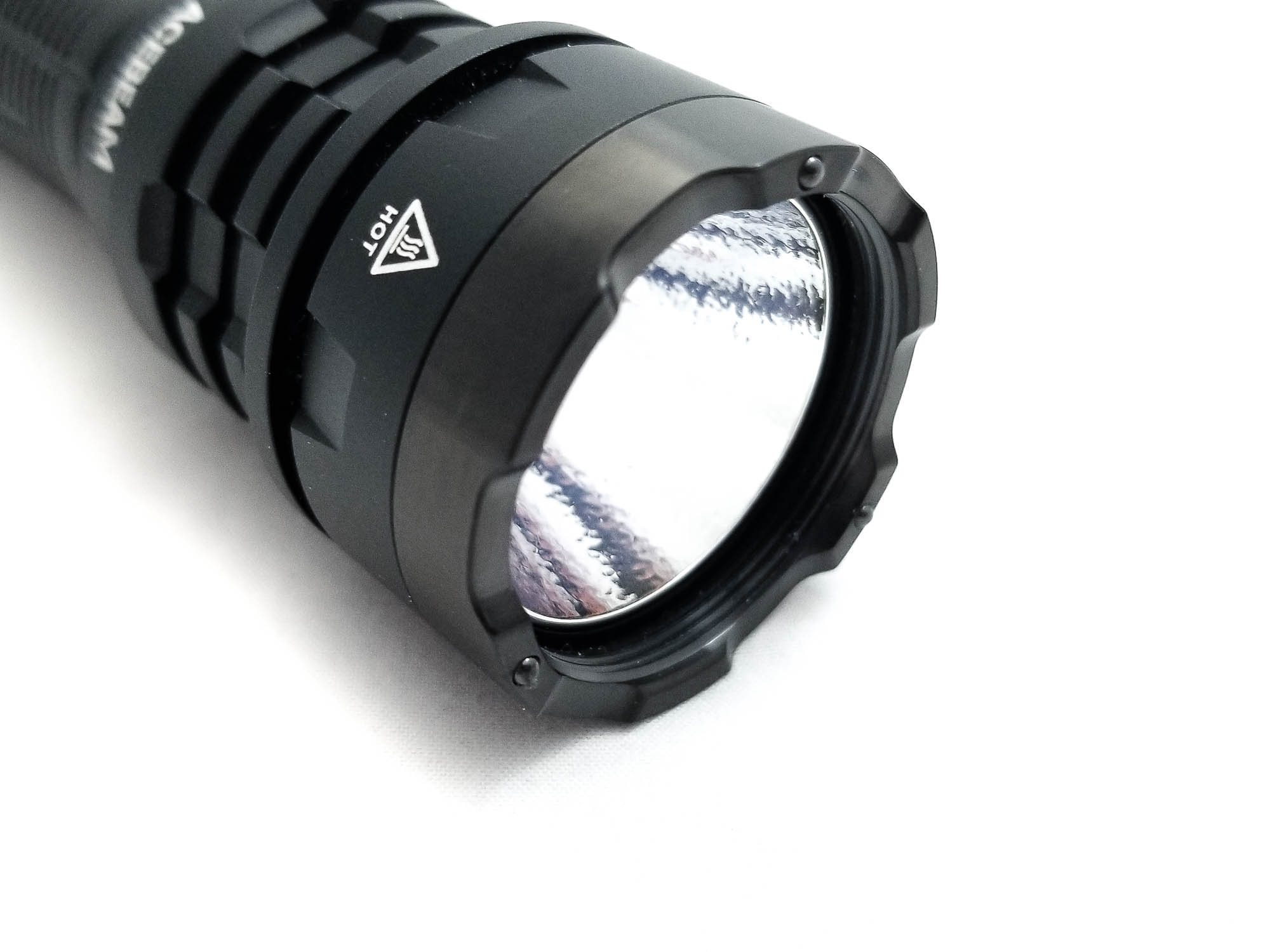
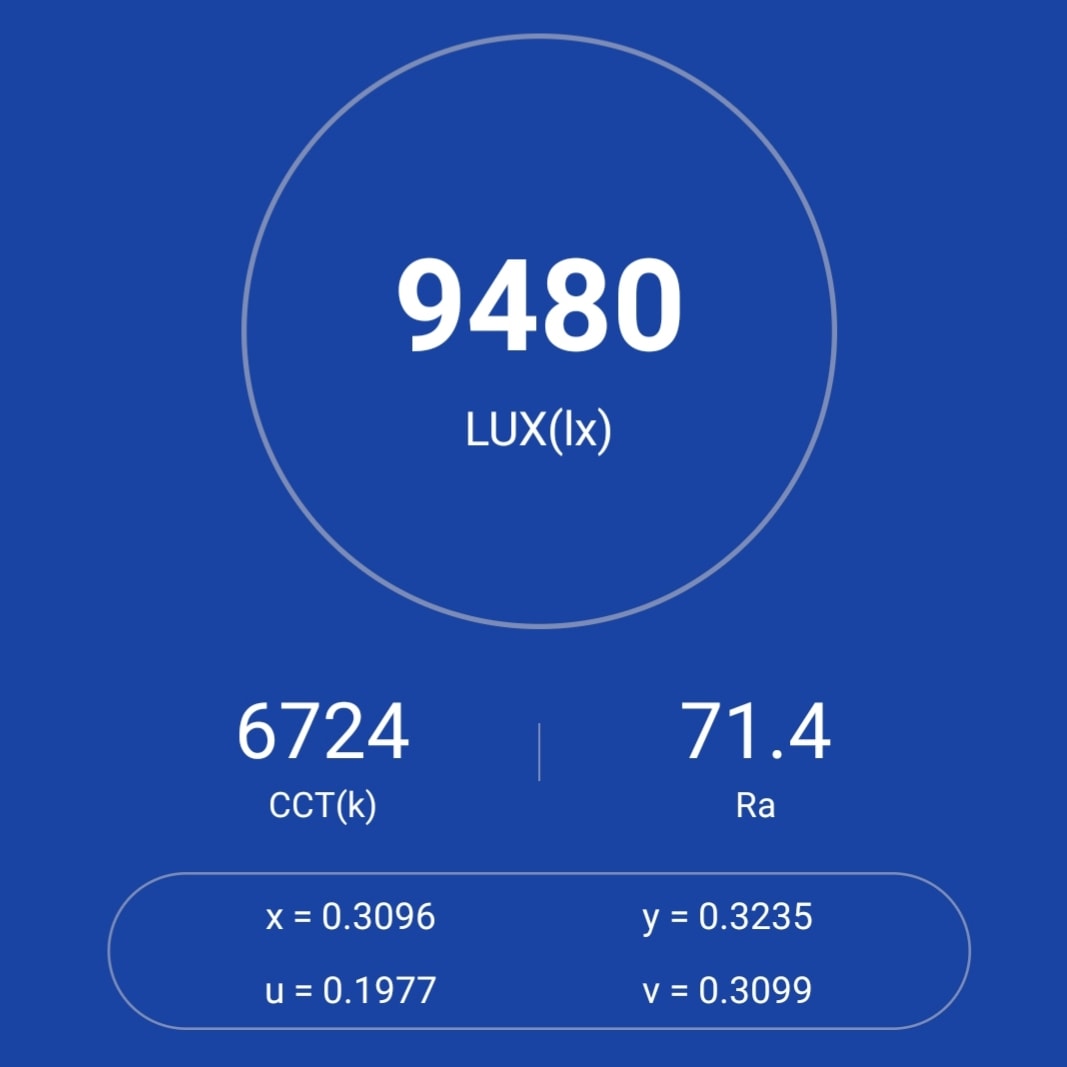
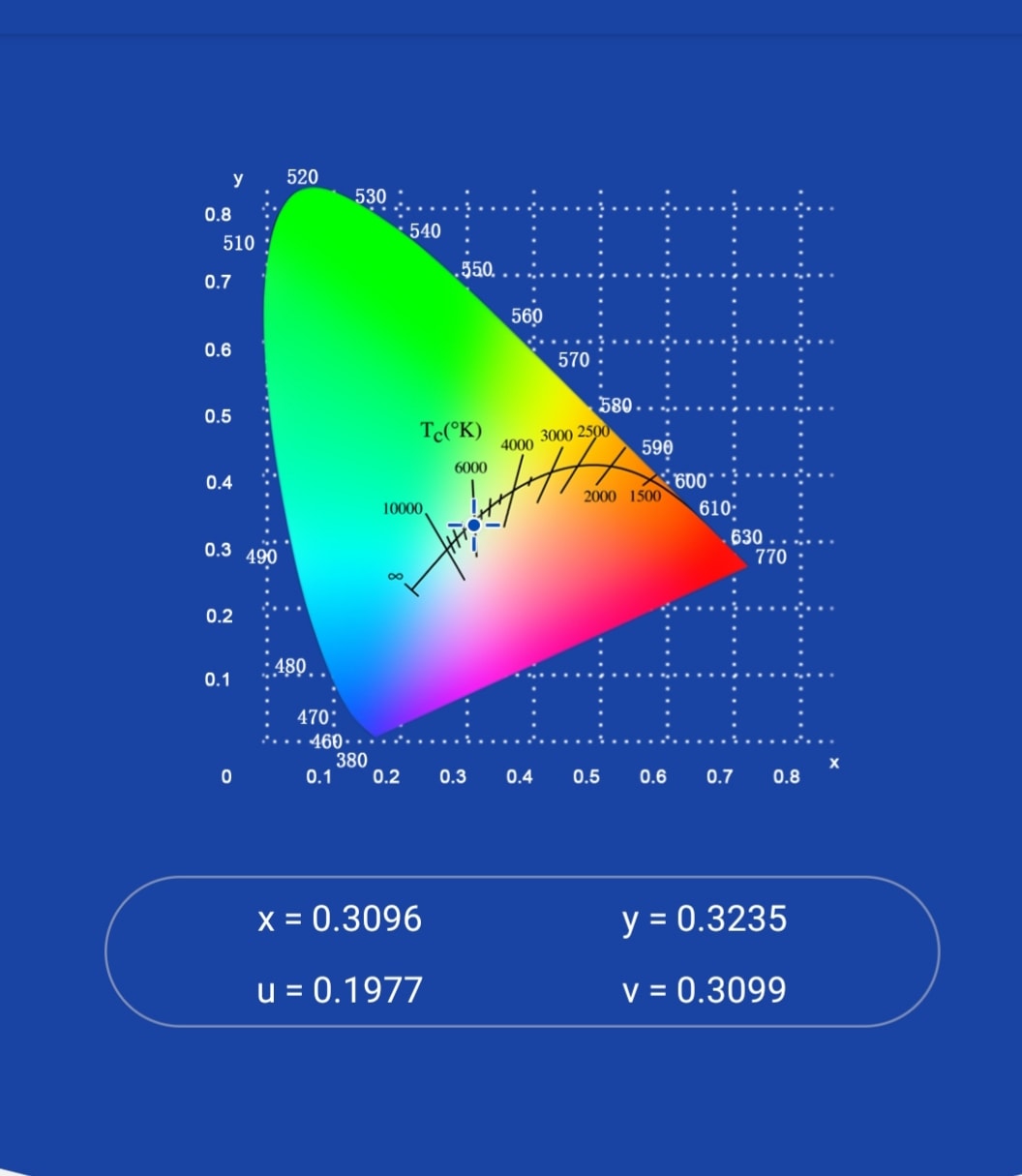
Dimensions and size comparison
Dimensions:
| Dimension | Millimeters | Inches |
|---|---|---|
| Length | 108 | 4.2 |
| Body diameter | 32 | 1.2 |
| Head diameter | 41 | 1.6 |
Dimensions are rounded to the nearest millimeter, and to the nearest tenth of an Inch.
Weight:
| Weight | Grams | Oz. |
|---|---|---|
| With included battery | 233 | 8.2 |
| Without battery | 155 | 5.4 |
Weight is rounded to the nearest gram, and to the nearest tenth of an Oz.
Flashlight size comparison with its competition
I compared the P17 to some other tactical lights and some similar lights. It’s comparable in size to a C8, so it’s pretty compact.The head is about the same size as a C8.
Group 1 left to right, some of the best tactical flashlights: Fenix PD36 Tac, Fenix TK20R V2, Fenix TK16 V2, Acebeam P17 Defender, Klarus XT11GT Pro 2
Group 2 left to right: Acebeam P17 Defender, Cyansky K3 V2, Thorfire C8
Group 3 left to right: Olight Warrior 3S Titanium SE, Acebeam P17 Defender, Acebeam P15 Defender, Emisar D1 2022
Group 4 top to bottom: Acebeam L18, Acebeam P17, Streamlight Stinger 2020

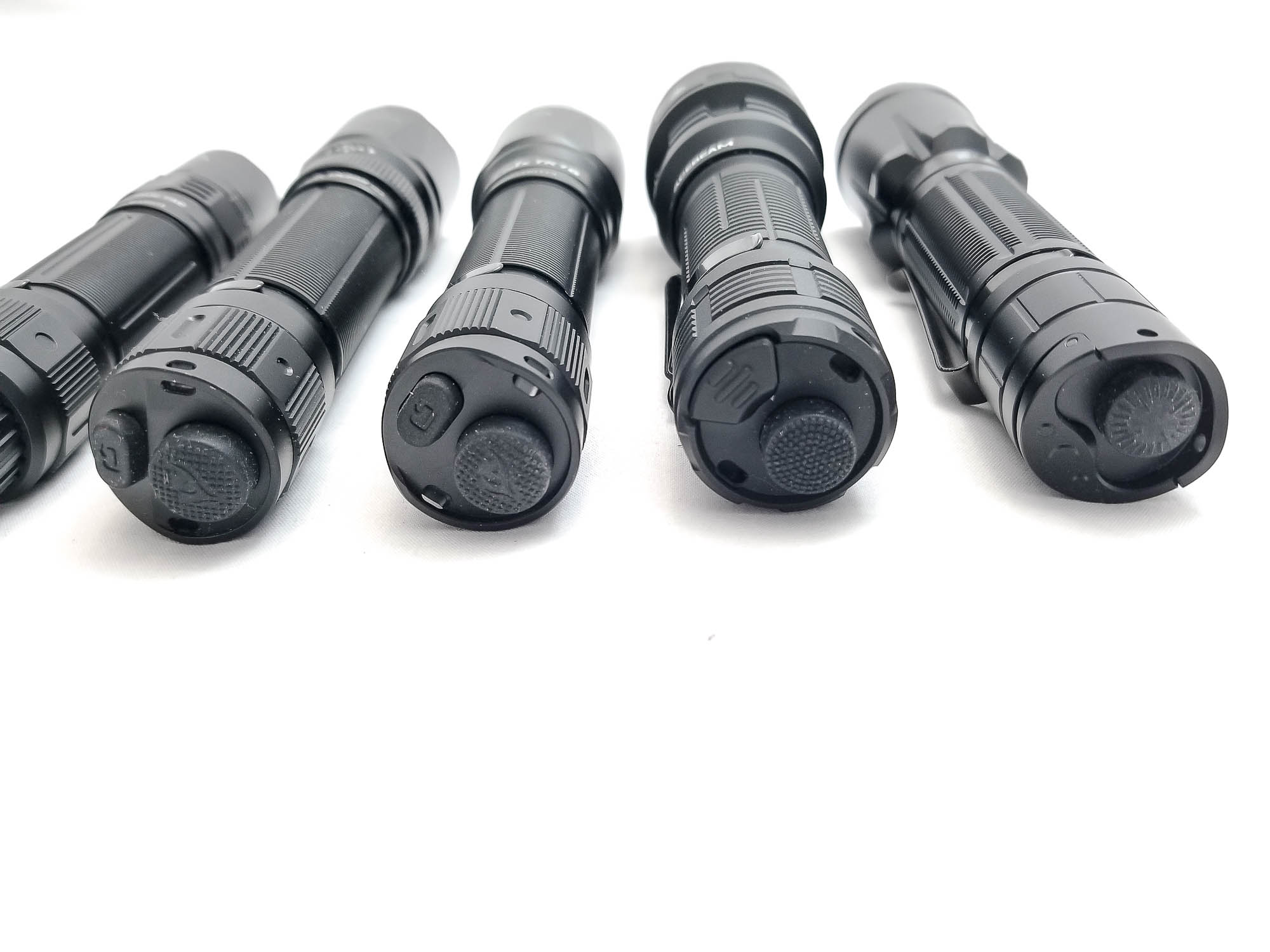
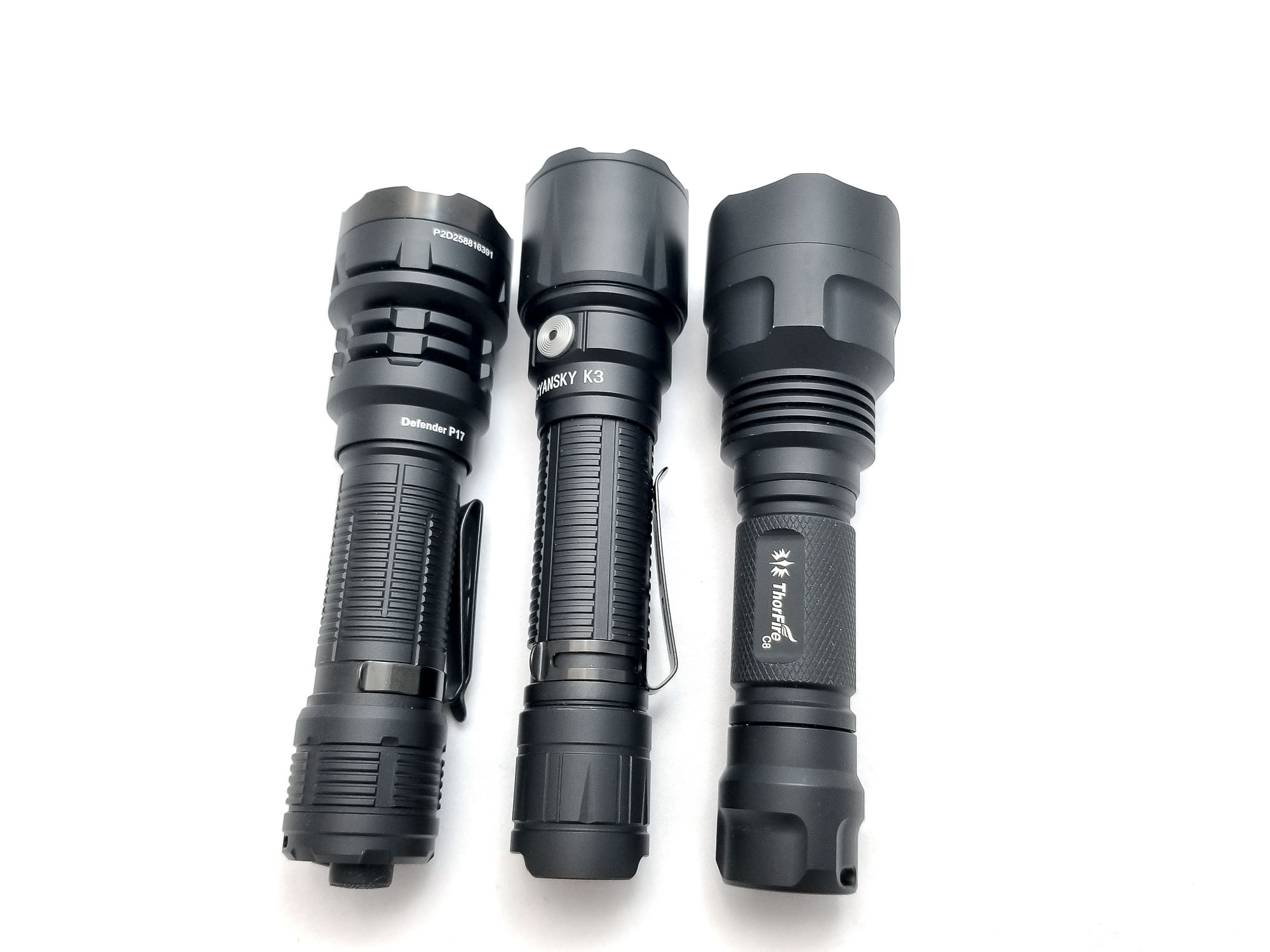
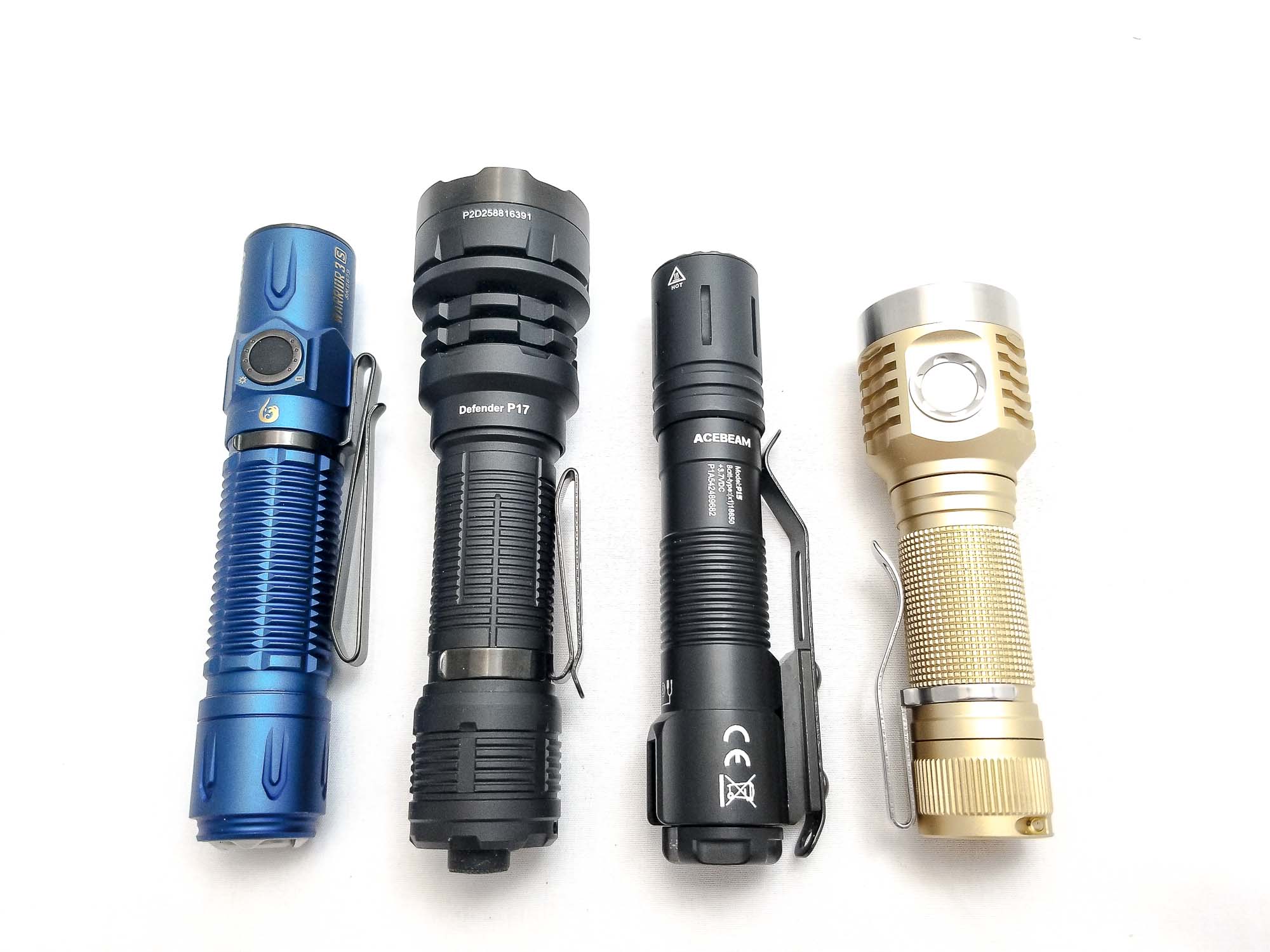
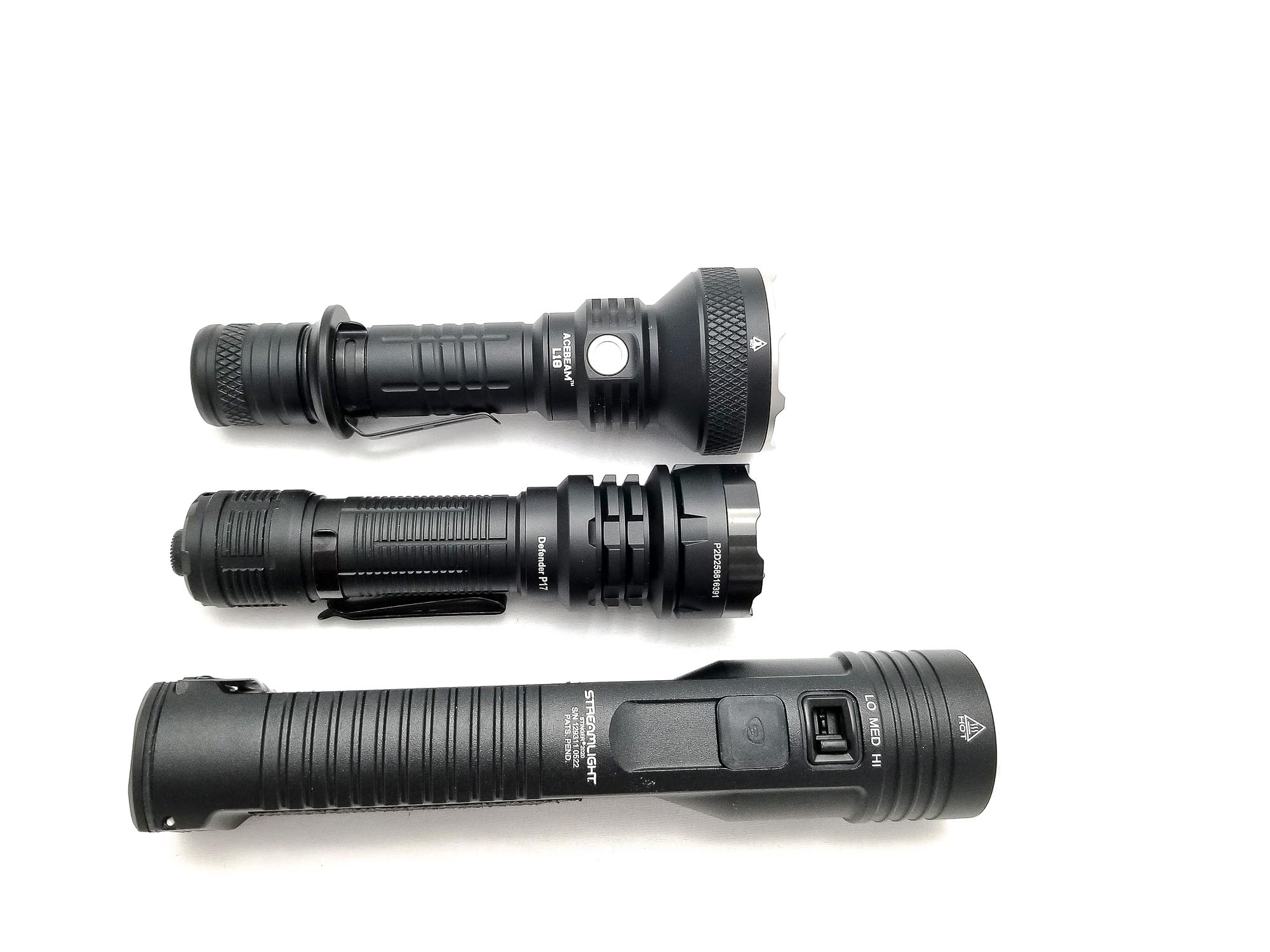
Driver & User Interface:
The driver is going to be a boost driver, since the XHP70.3 is a 6 volt or 12 volt LED. Acebeam produces some fantastic electronics, and these are constant-output drivers with great, laminar output for continuous output that doesn’t track with the battery voltage sag. This is a very important feature for lights going into the field for pro use.
The UI is unique for a tactical light, and to be honest, it’s a bit busy, but Acebeam did a good job with the execution. The UI itself is broken down into 3 mode set groups, and each works with the dual switches for different functions. Switching between the three modes is pretty straightforward: From off, click and hold the Function switch for three seconds. While holding down the Function switch, press the Tactical switch to enter the mode selection function (the light will ‘breathe’). Click the Function switch again. Strobe means Tactical Mode 1, High mode is Tactical Mode 2, and SOS is Daily Mode. Click the Tactical switch to set the mode.
Available Modes:
Daily Mode: Ultra Low, Low, Medium, High, Turbo
Tactical Mode 1: Turbo, High, Medium, Low, Strobe
Tactical Mode 2: High, Low, Ultra Low
From OFF:
- Tap Tactical switch: Momentary on in last memorized mode for Daily Mode or Tactical Mode 1
- Fully click Tactical switch: Turns on in last memorized mode
- Tap Function switch:
- Daily Mode: Momentary Ultra Low mode
- Tactical Mode 1: Strobe
- Tactical Mode 2: Momentary High Mode
- Press and hold Function switch:
- Daily Mode: Locks in Ultra Low Mode after pressing for three seconds
- Tactical Mode 1: Locks in Strobe after one second
- Tactical mode 2: High Mode
- Click the Function switch again to return to ON and mode switching in Daily Mode and Tactical Mode 1. Turns off in Tactical Mode 2.
From ON (Daily Mode):
- Single click Function switch: Switches modes L-M-H-T-L
- Press and hold Function switch for more than one second: Locks in SOS
- Single click Tactical switch: Turns off
From ON (Tactical Mode 1):
- Single click Function switch: Switches modes L-M-H-T-L
- Press and hold Function switch more than one second: Locks in Strobe
- Single click Tactical switch: Turns off
From ON (Tactical Mode 2):
- Single click Function switch: Switches modes H-L-Ultra Low
- Single click Tactical switch: Turns off
Mode memory:
- Yes, last mode memory in Daily or Tactical Mode 1. None on Tactical Mode 2.
Low voltage warning:
- The battery has a protection circuit
Strobe/blinkies
- SOS and variable Strobe in Daily and Tactical Mode 1. None in Tactical Mode 2
Lock-out mode:
- None. Unscrew the tailcap ⅛ turn to lock out
Shortcuts:
- None
PWM
- None
Additional info: The UI is a bit busy for a tactical light, and some important features are present, like direct access to Turbo/High mode. I like the nice assortment of modes here, and it makes for a versatile flashlight. I think Tactical 1 Mode is a bit unnecessary and superfluous though, since it’s basically just like Daily Mode with Strobe swapped for Ultra Low. Personally, it would be better to add Strobe to Daily Mode and call it good. I do have one critique, and that’s there is no direct access to Strobe in Tactical 2 Mode and I think that is really important, since it’s the closest to a true tactical mode. Although Acebeam does give you direct access to High mode in the Tactical 2 mode group, and it’s pretty bright, it’s still not the retina-melting Turbo I’d like to see. Strobe mode can be an important self-defense option when a sidearm or other weapon cannot be quickly presented to disorient the assailant or suspect to give the operator time to evade or find cover. LVP isn’t mentioned in the manual anywhere, but the battery has a protection circuit that should pull the plug when the voltage gets to around 2.5 volts.
Acebeam P17 Charging and Batteries
The P17 takes a 21700 battery and Acebeam includes one with the light, which is always nice. It came charged to 3.63 volts for storage, which is perfect. The battery is Acebeam’s IMR21700NP-510A. This is a button top 5100 mAh 18.5 Wh high discharge 21700 battery. This battery isn’t proprietary, and the P17 happily digested every 21700 I stuck in the tube: flat top, and button top, protected and unprotected. The flat top Samsung 50S flat top did rattle around in the tube though.
The included battery adds a protection board and onboard USB type C charging, which is good since Acebeam omitted onboard charging. While I really like onboard charging, I get it that a charge port and cover are just things to break and wear out and add entry points for moisture and detritus, so it’s definitely not a deal-breaker in this application. No charge current is listed, but I connected it to a PD power bank with the included USB A to C cable and saw around 1.4 amps on the discharged battery. A type C to C cable wasn’t much better, so plan on a 3.5 hour recharge for this battery.
There’s a tiny hole on the top insulator with an LED underneath for charge state: Red for charging and green for charged. The charge termination voltage was right around 4.10 volts, which is way down from the 4.2 volts on the wrapper. I did notice that once the charge termination indicator turned green, the battery was still consuming about 350 mA of current, so I let it sit overnight (8 hours), and the charge termination voltage hadn’t changed.
While this is good for the battery’s longevity, you are losing a small amount of runtime. It’s worth mentioning (again), the included charge cable is so short it’s pretty useless, and only good for using with power banks.
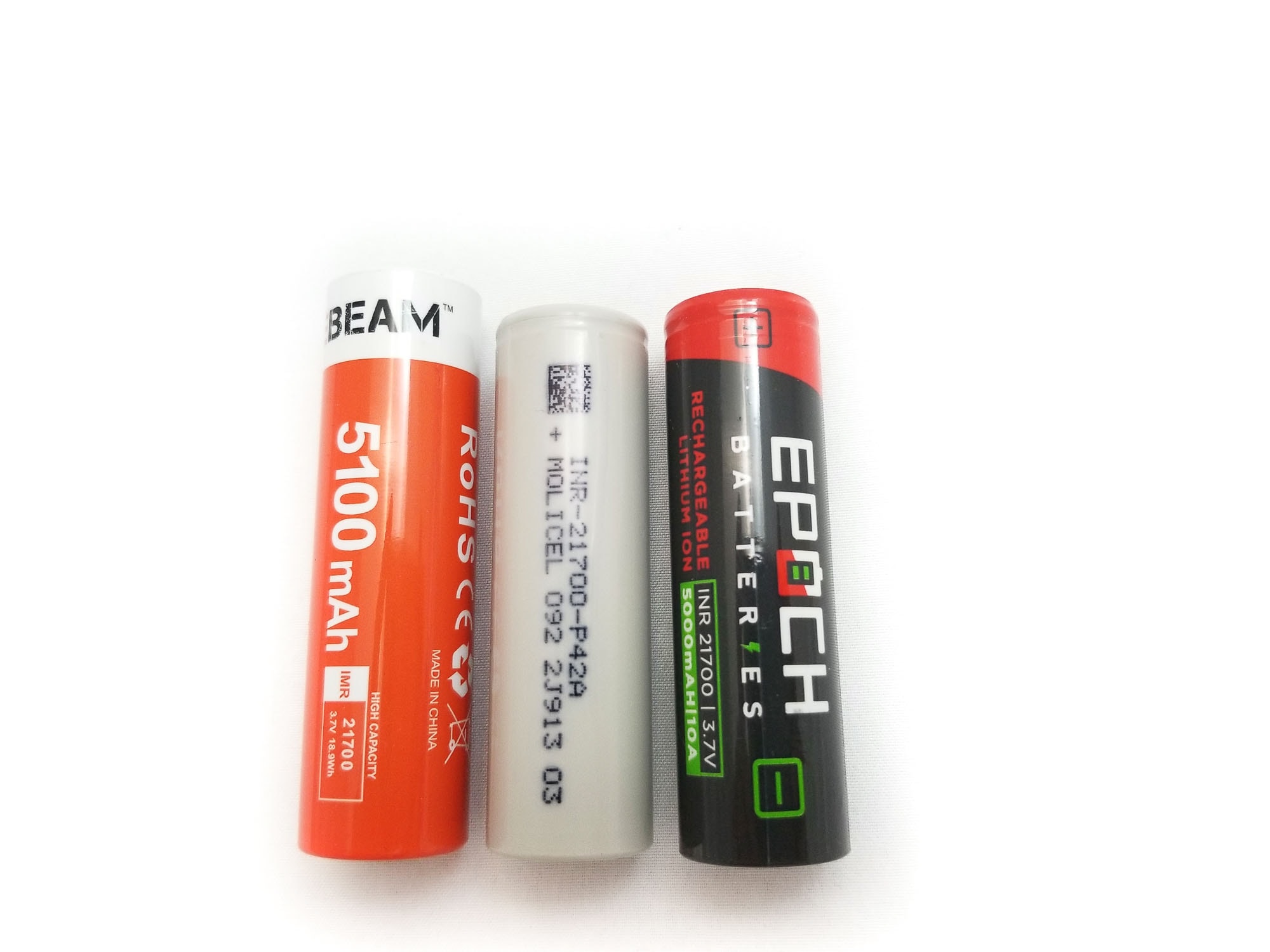
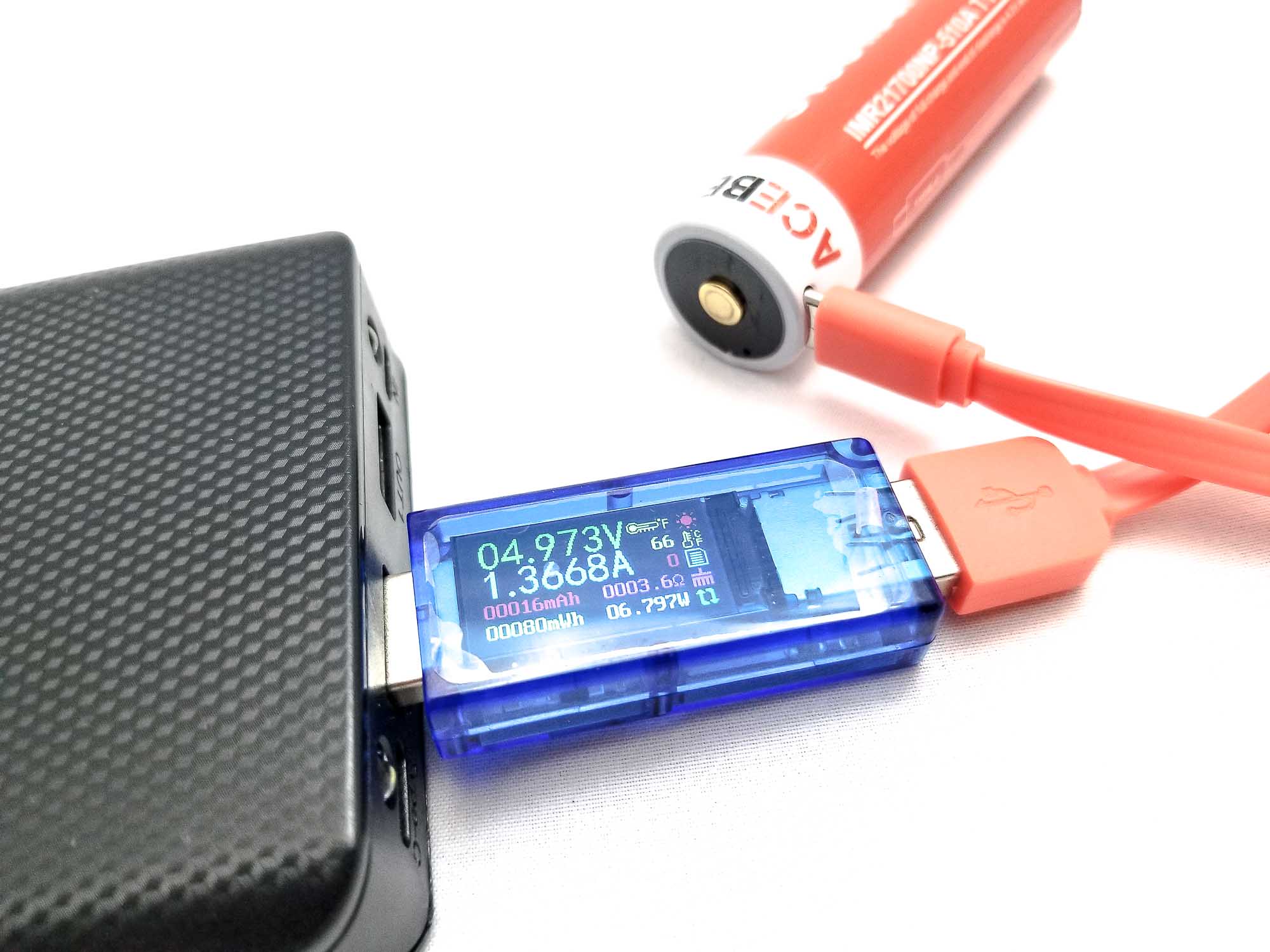
Performance test
Lumen measurements
Lumens are measured in my 50 cm integrating sphere with a Digi-Sense 20250-00 data logging luxmeter. The sphere has been calibrated with a Convoy S2+ measured to 260 Lumens and the figures are within 10% of actual. I used the included IMR21700NP-510A 5100 mAh 21700 and tested Medium, High, and Turbo modes. No amps this time due to the wonky current path.
| Mode | Specified | turn on | 30 sec | 10 minutes |
|---|---|---|---|---|
| Ultra Low | 3 | 1.2 lm | 1.2 lm | – |
| Low | 90 | 84 lm | 84 lm | – |
| Medium | 580 | 468 lm | 468 lm | 468 lm |
| High | 2200 | 1,812 lm | 1,800 lm | 1,668 lm |
| Turbo | 4900 | 4,332 lm | 4,044 lm | 1,032 lm |
The output is coming in a bit low, but within my 10% window for actual output, so once again, I’d trust Acebeam’s output figures here.
Parasitic drain:
- 1.75 mA
Acebeam P17 Battery Life and Runtime graphs
Runtimes are measured in my 50 cm integrating sphere with a Digi-Sense 20250-00 data logging luxmeter. The sphere has been calibrated with a Convoy S2+ measured to 260 Lumens and the figures are within 10% of actual. I used the included fully charged IMR21700NP-510A 5100 mAh 21700 and tested Medium, High, and Turbo modes.
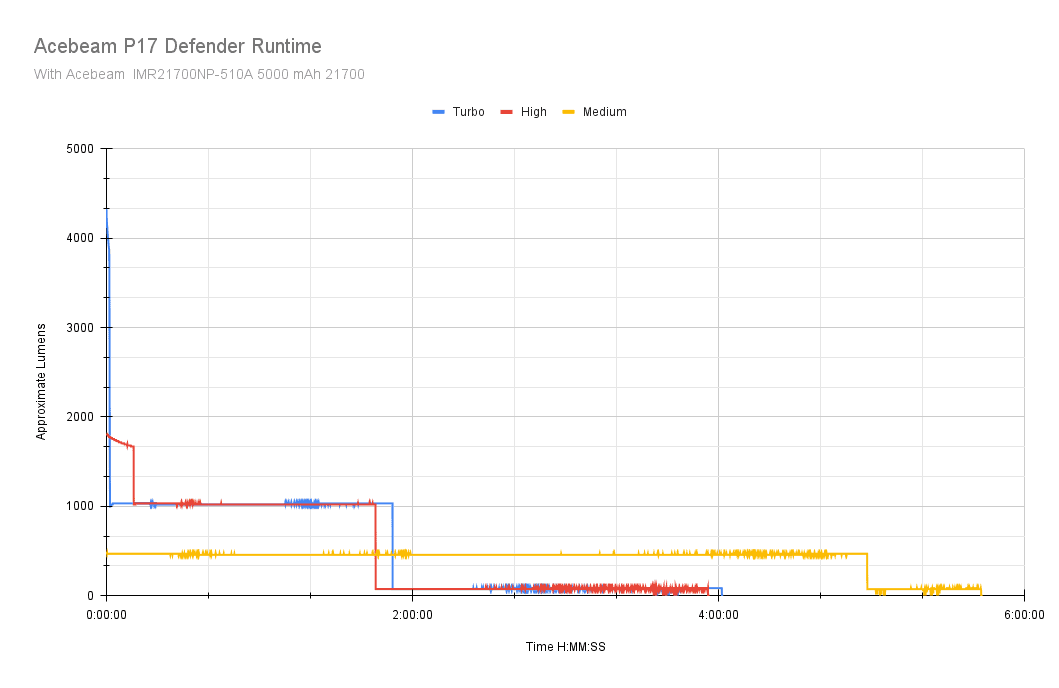
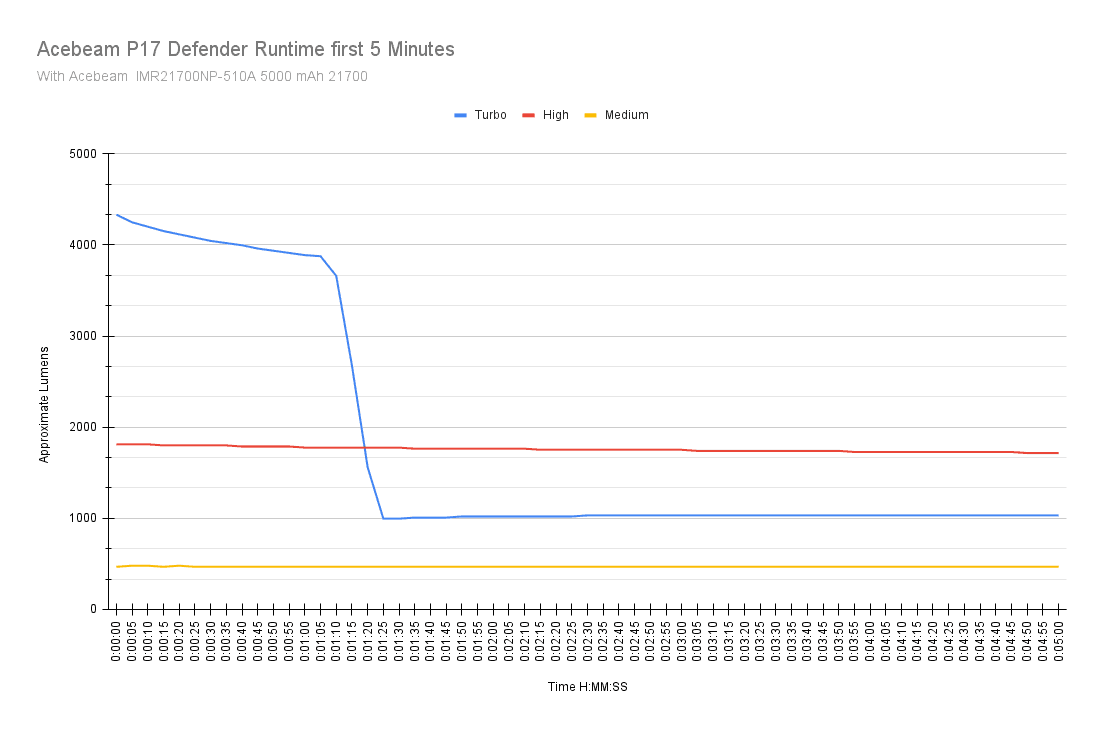
| Mode | Specified | Measured runtime (ANSI) | Time till shut off |
|---|---|---|---|
| Medium | 5h 50m | 5h 42min | 5h 42min |
| High | 2h 56m | 1h 45min | 3h 55min |
| Turbo* | 2h 55m | 1h 52min | 4h 1min |
The runtime graphs affirm the type of driver in the P17 Defender, and this is a common denominator in all my Acebeam tactical lights: A constant current (boost in this case) driver. The output is laminar, only interrupted by timed step downs and thermal limiting. This is an extremely important feature in a ‘working’ light, since duty requires continuous brightness that doesn’t drop as the battery dumps, with very good regulation.
On Turbo, from 21 ambient to 45 C took 30 seconds, up to 52 C before the 30 second step down. Max temperatures measured during the Turbo and High tests never crested 55 C, and the light was hand holdable for the Turbo and High tests at 45 C.
High mode maintains over 1500 Lumens for nearly 11 minutes, and over 1000 (like Turbo) for the majority of the runtime. Turbo maintains almost 4000 Lumens for over a minute, which is impressive for a light like this. There is visual LVP at work, which started for about the last 5 minutes of the runtimes, with 3 blinks spaced about 2 minutes apart. The light was usable after the High and Medium tests, with only Ultra Low available after the High test, and what looked like Low mode after the Medium test. My runtimes are coming in a bit under advertised. The battery was discharged to 2.8 volts after each test.
ANSI FL1 standards: The runtime is measured until the light drops to 10% of its initial output (30 seconds after turning on). This does not mean that the flashlight is not usable anymore. The last column shows how long the light actually works till it shuts off. If there is a + symbol, it means that the test was stopped at that particular point, but the light was actually still running. This happens on certain occasions, with certain drivers, firmware, or batteries.
Peak beam intensity and beam distance measurements
Beam distances are measured using a Uni-T UT383S luxmeter measured indoors at 5 meters using the included fully charged IMR21700NP-510A 5100 mAh 21700. Measurements taken at 30 seconds.
| Mode | Specified | Candela measured | Meters | Yards |
|---|---|---|---|---|
| Ultra Low | – | N/A | N/A | N/A |
| Low | 2070 cd | 850 | 58 | 64 |
| Medium | 7396 cd | 5325 | 146 | 160 |
| High | 24,336 cd | 20,625 | 287 | 314 |
| Turbo | 49,506 cd | 46,500 cd | 431 | 472 |
No reading at 5 meters for Ultra Low, and I’m coming in low on the figures compared to Acebeam’s numbers, but this is still good performance for a 40 mm head with a large LED and more than enough reach for most tactical scenarios.
Extra info: Peak beam distance according to ANSI FL1 standards: The calculated value of distance in meters at which the flashlight produces a light intensity of 0.25 lux. (0.25 lux is about the brightness of a full moon shining on an object). Columns Meters and Yards show rounded numbers.
Beamshots
I compared the P17 Defender to some other tactical flashlights. Photos taken with my Samsung Note 8. The 95 meter shots with the camera set to 0.3s ISO 200 and 5000K WB. Most of these lights have either Luminus SST70 or SFT-70-W (Fenix TK20R V2, Olight Warrior 3S), with the Stinger 2020 sporting a XHP50.2. The little sibling P15 has just 1600 Lumens from the SFT-40-W.
Beamshots of the following flashlights compared:
- Fenix TK20R V2
- Fenix TK16 V2
- Fenix PD36 Tac
- Klarus XT11GT Pro 2
- Olight Warrior 3S SE copper
- Streamlight Stinger 2020
- Thrunite BSS V4
- Cyansky K3 V2
- Acebeam P15 Defender
- Acebeam P17 Defender
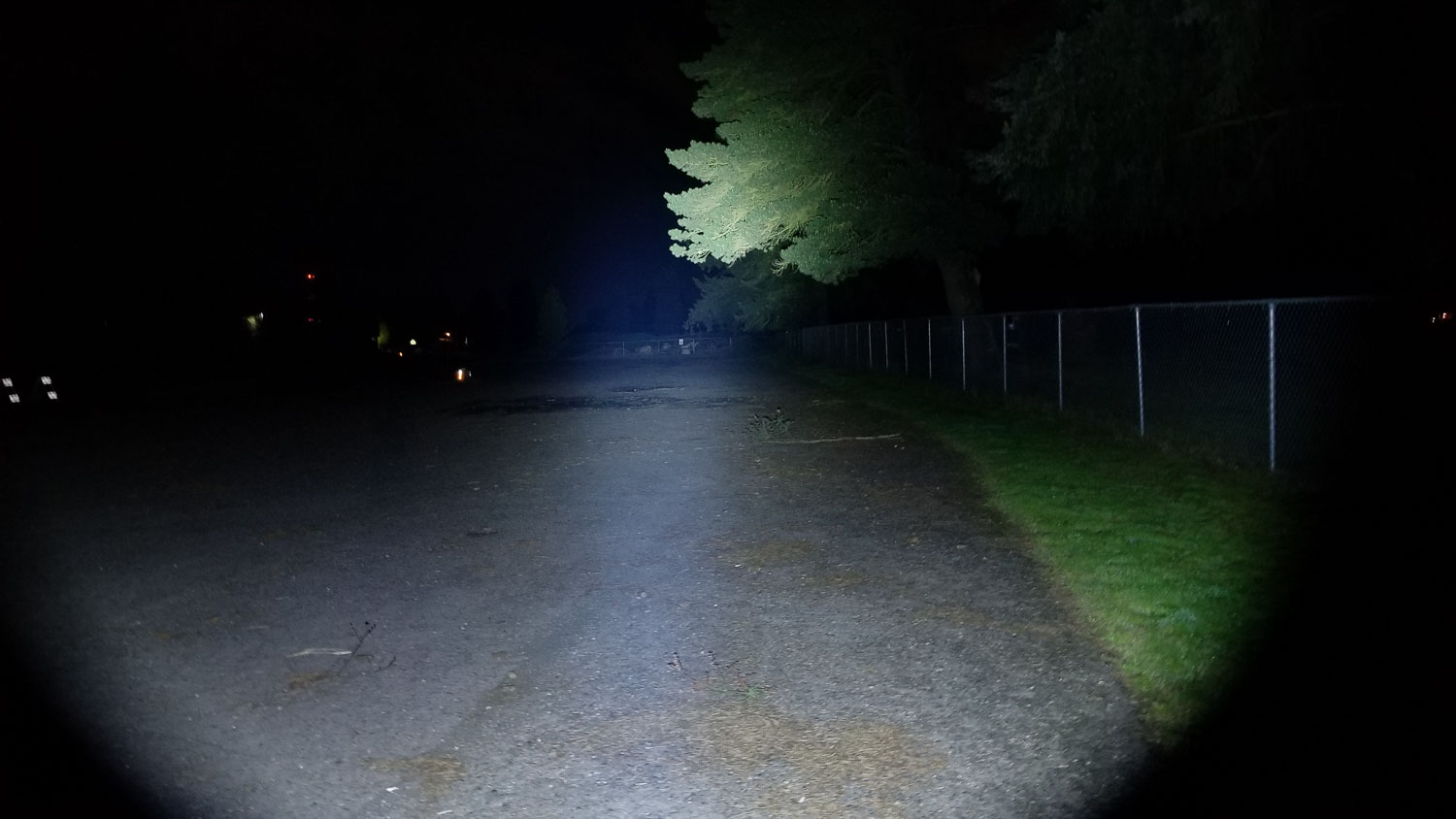


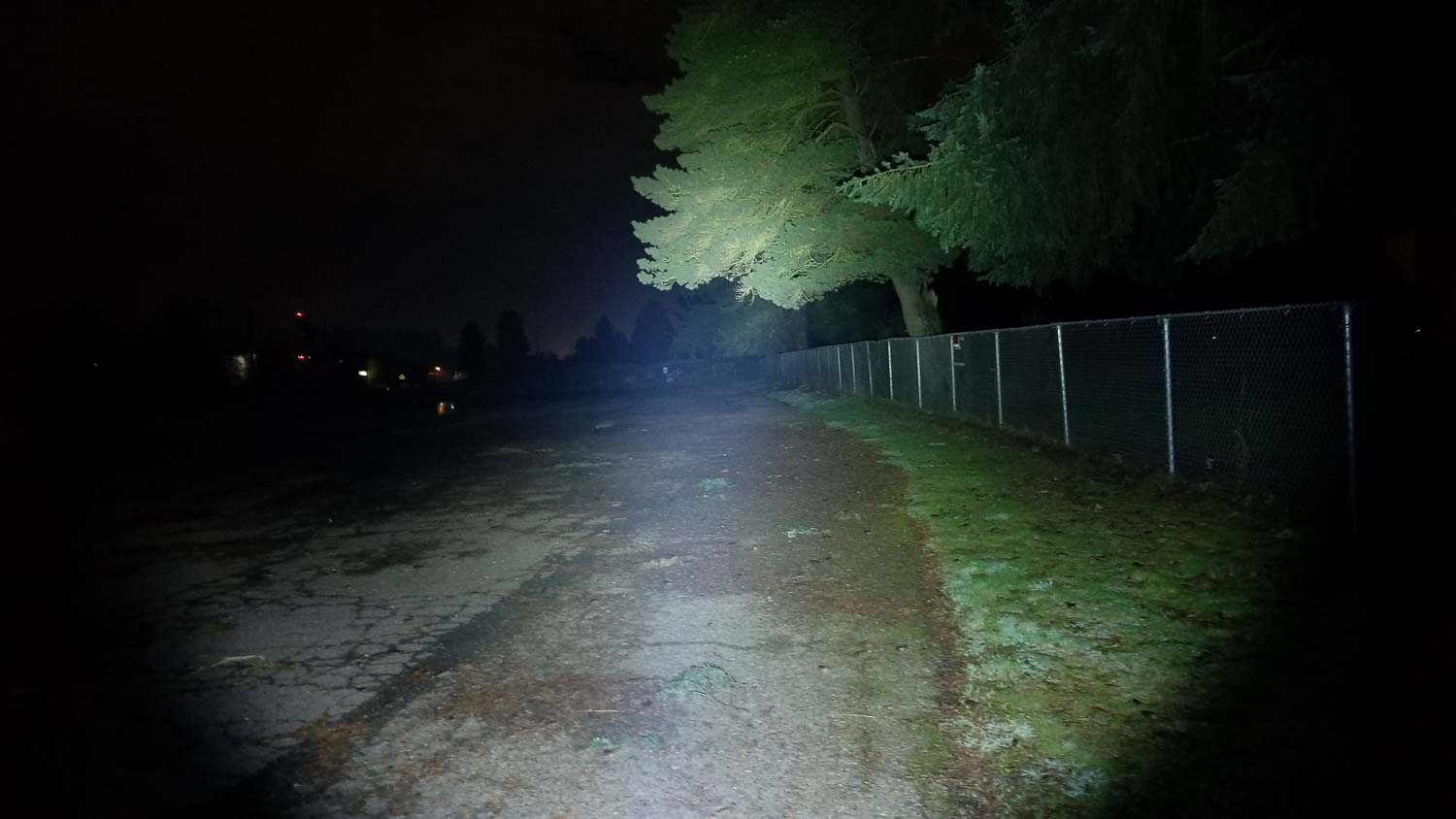



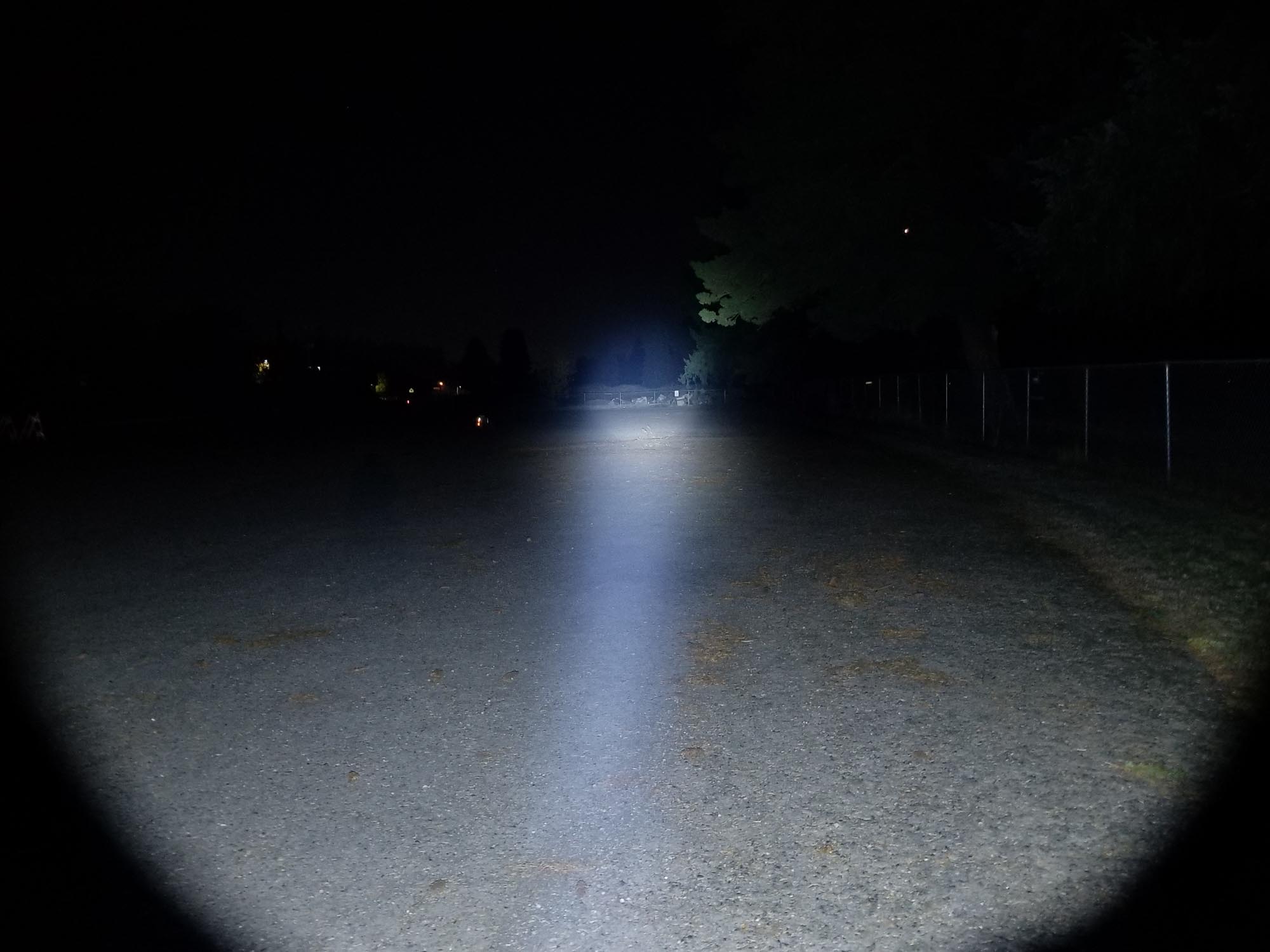

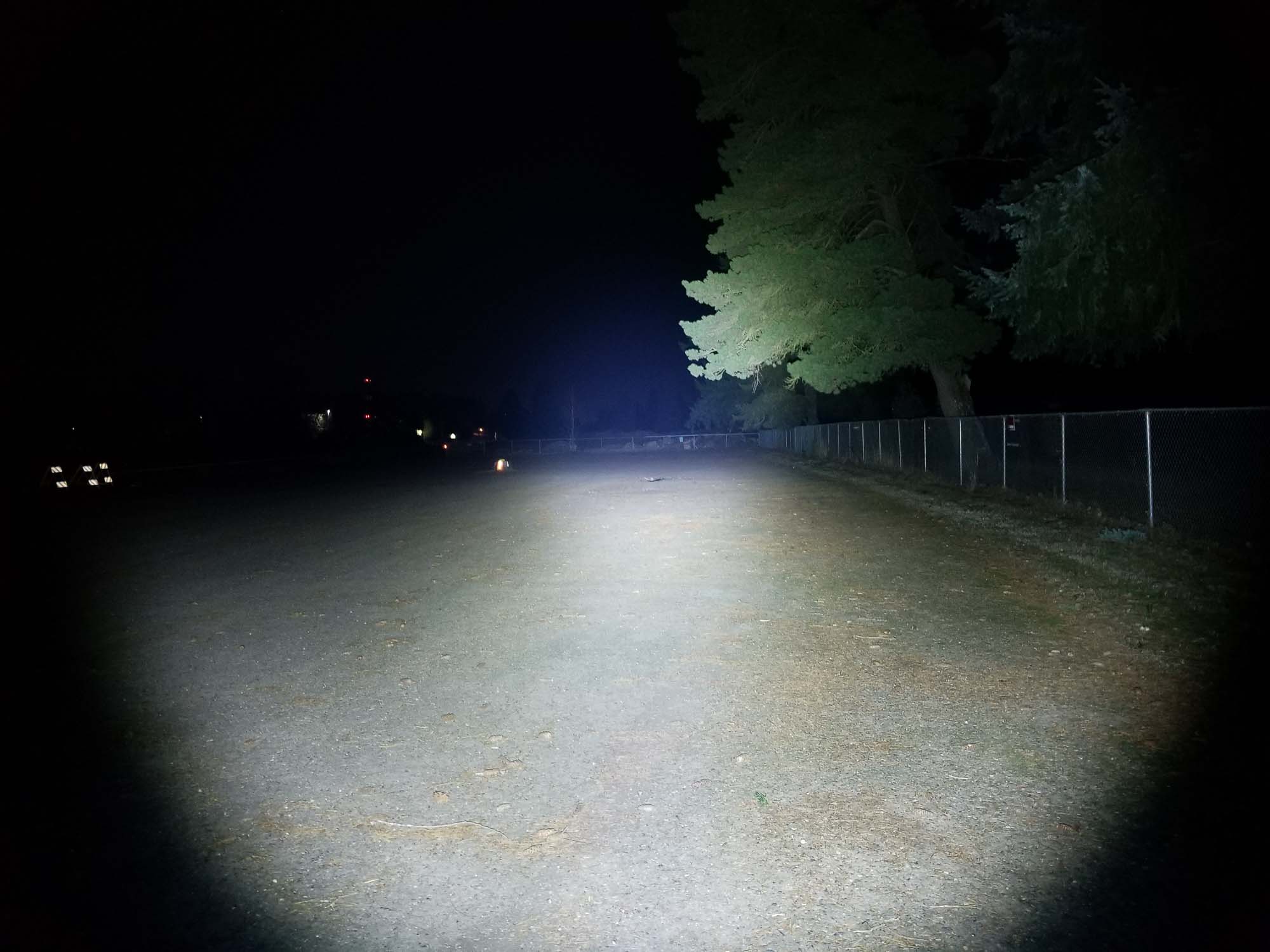
Disclaimer: This flashlight was sent to me for review at no cost by Acebeam. I have not been paid to review, nor have I been holding back on problems or defects.
Final Verdict
Pros
- Fantastic quality, fit and finish
- Excellent anodizing
- Nice beam and tint
- Dual-switch UI
- Constant current driver with good sustained output
- No proprietary battery
Cons
- Slow charging
- UI could use some revision
- No holster or lanyard?
Explanation on star ratings:
1: Avoid: a match would be a better choice – 2: Poor: significant defect or issues; almost unusable – 3: Average: some defects or issues; but still usable 4: Good: recommended (minor issues) – 5: Great: highly recommended

4.5 stars: ★★★★⋆
There’s a few things we can more or less count on in life: Death, taxes, and the fact that Acebeam makes some great flashlights and the P17 Defender drives that home. The only other competitors in this bracket are the Fenix TK20R V2 and TK16 V2, and Olight Warrior X 3, and those are down about 1500 Lumens in output.
The P17 Defender is a bonafide tactical-use light. The addition of the XHP70.3 really adds a great deal of performance over the SST70 and SFT-70-W equipped competitors with what I see as a nicer beam. There’s plenty of throw and more than enough output. The fit and finish and attention to detail are exemplary, combined with the easy handling and maneuverability make this a nice light to tote around.
The fit and finish are exemplary as expected, and the performance is also excellent for a small light with constant output. While not a huge deal for some, I really applaud Acebeam for keeping the P17 compatible with regular 21700s and no proprietary nonsense. I think the UI could use some tweaking to make it more flexible in tactical scenarios, along with some revisions to the Function switch, there’s not too much to detract from the overall usefulness or functionality.
I would like to see Acebeam include a hoster (either a hard or soft one), a lanyard, and the charging speed is pretty pathetic for 2023, but those are easy fixes. For late 2022, the P17 Defender was a welcome addition to Acebeam’s tactical-use lineup, which was due for some new arrivals. In fact, there’s really no other XHP70.3 tactical-use or duty lights on the market (yet), and it works great in this application. If you need a tactical-use or duty light with more output than current 21700 size tactical lights can offer, an excellent electronics package, and typical no-nonsense Acebeam quality, fit, and finish, pick up a P17 Defender. 4.5 stars.
Buy your Acebeam P17 here with a discount
Get a whopping 15% off your next order at Acebeam.com with the following discount coupon: AE15. Simply add the coupon code at your checkout.
1lumen selects and reviews products personally. We may earn affiliate commissions through our links, which help support our testing.